What's discussed in this post
Introduction
You just finished your draft. Congratulations!
… Now what? Even for the experienced author, revising a short story or novel can be a daunting task because the advice out there is often this broad or vague. Authors need specific and actionable advice so they feel confident in approaching a revision. That’s where the developmental edit comes in. A developmental edit is an evaluation of a manuscript's bigger picture (or macro) elements, which includes character, stakes, and plot. It may also address some micro edits such as pacing, structure, showing and telling, point of view, and tension. The point is to get the bones of the story in proper shape. While hiring a professional to perform a developmental edit or editorial critique is always a good option, every author should attempt to do it themselves first. Learning to evaluate your own manuscript will not only help you hone your craft, but it will save you money. The structure of a developmental self-edit
So, what is the structure of a developmental self-edit? Here’s the basic outline:
This post goes into how to perform a cold read. By the end, my hope is that you can approach this first step of revising your manuscript with confidence and clarity. What is a cold read and how do you do one?
For a developmental editor, the cold read is the first read-through of the manuscript. Reading through the manuscript prior to digging into a developmental edit allows an editor to get an overall feel of the manuscript’s character, plot, stakes, and themes; the author’s style; and the obvious issues to address. Typically, no actual editing is performed on this first read, but the editor will have a checklist or notepad nearby to jot down notes or ideas.
A cold read is more easily done by a developmental editor because the manuscript isn’t precious to them. They go into the read with the needed objectivity. As the author, you don’t have that advantage. So, the first step of performing a cold read is to gain objectivity, and the second step is the read-through. Step 1: Gain objectivity
What you and your manuscript really need is objectivity. Here are three ways to help you get it:
1. Take time and distance away from your manuscript
Established authors, editors, agents, and book coaches all emphasize the importance of stepping away from your manuscript, giving it (and you) time to rest. I’ve seen many suggest letting the manuscript rest for at least six (6) weeks. This is often easier said than done. Sometimes, we are too excited to put our manuscript aside for long, and other times, we are on deadline, whether self-imposed or not. However, Tiffany Yates Martin says even a few days away from the manuscript can be effective—if you distract yourself. Here are some distraction methods:
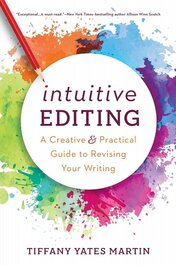
General Revision – Intuitive Editing by Tiffany Yates Martin. I cannot recommend this book enough. It’s the first book on revision with clear, practical, and actionable advice. It makes my neurodivergent brain happy.
Show vs. Tell – I haven’t seen a better book on showing and telling than Understanding Show, Don’t Tell (And Really Getting It): Learn how to find—and fix—told prose in your writing by Janice Hardy. Like Intuitive Editing (which has a chapter on this!), Hardy’s book gives actionable advice with great examples. Both books have the format of “how to find it and how to fix it,” which I find extremely helpful!
Short stories have the added benefit of helping you hone your craft while you create something for your newsletter. Pick up Brevity: A Flash Fiction Handbook by David Galef to learn about the different formats of flash fiction and how to revise it.
Tip: Explore a new genre through a short story. It will distract you even further from the book you just finished.
2. Read the manuscript in a different place than you wrote it
As Yates Martin says, “The brain is a creature of habit.” So, if you try to read your manuscript in the same place as you wrote the draft, your brain will go back into writing mode. You want it in reader mode!
3. Read the manuscript in a new format
This is an essential part of the editing process, I believe. Putting your manuscript in a new format—whether it's a printout, a paperback ordered off of Lulu, on your e-reader, or even with just a different font—tricks your brain into thinking it's not yours and therefore allows you to enjoy it as a reader would.
Step 2: Read your manuscript
Next, you’ll want to read your manuscript in as few sittings as possible. Make sure you have a notepad, notecards, etc. nearby to jot down issues you notice or improvement ideas. DO NOT mark up the manuscript itself (which is why putting it on an ebook reader is such a brilliant idea). If you begin marking up the manuscript, your brain will flip into writer and revision mode, and we’re only focusing on identifying issues and improvements right now.
Also, don't forget to write down good things about your manuscript! What did you enjoy? What is working? Highlight your favorite lines! You'll be happy to have a reminder of what is good about your manuscript as you dig into the revisions. Once you're done with your cold read, it's time to let your first impressions simmer. Our unconscious discovers wonderful ideas when we let it. Leave your manuscript for a couple of days, let your unconscious do its magic, and never be without the means to take notes! To sum it up
Every author should learn how to perform a developmental self-edit because it will not only help them hone their craft but also save them money. A cold read is the first step of a developmental self-edit, and to perform an effective cold read, you need to obtain objectivity. Take time away from your manuscript if you can, and if not, read your manuscript in a new format and a new place than you wrote it. Read your manuscript in as few sittings as possible, and then let your unconscious work its magic before you start on the next step: Evaluating your manuscript.
0 Comments
What's discussed in this post
What is cohesion and why is it important?
When reader expectation is not met, the narrative may read awkwardly, causing the reader’s concentration to break briefly or the reader to backtrack to glean meaning out of what they just read. This disrupts the reader’s immersion and gives them the opportunity to put down your book! This guide explains how to meet reader expectation at the sentence level with the known-new contract, repetition, and parallelism, so you can revise your sentences for cohesion with confidence. The known-new contractOut of the 3 techniques used to create cohesion, the known-new contract is the most important because it’s how the reader learns new information: by connecting it to what they already know. If you struggle with meeting the known-new contract, your sentences may provide new information consecutively, creating a choppy, disconnected flow. To understand this concept, we need to go over how sentences present information:
Starting with a simpler concept of what the reader already knows de-emphasizes it and allows the reader to focus and understand the new information. The new information should be presented in the predicate, where the natural emphasis is, because it allows the reader to retain more complex information and carry it onto the next sentence.
This sentence couplet comes in the scene right after the protagonist, Icelyn’s pet mini-dragon (Ember) had gone missing, sending Icelyn into a depressed panic. Since the reader would already have that in the foreground of their mind, Clemens begins the sentence with Ember finding her way home yesterday and ends with how Icelyn feels today about it, was such a relief it made today feel brighter, which is new information to the reader. In this case, the known-new contract also has a cause-effect structure. Clemens uses cause-effect to connect the first sentence to the second. The effect of Icelyn Humming a winter tune isn’t new information because it is caused by and exemplifies Icelyn’s relief making the day feel brighter, and those emotions are pulled through and motivate Icelyn’s actions in the rest of the sentence. RepetitionThis may seem like a promotion for redundancy, but there’s a major difference between redundancy created through repetition and repetition as lexical cohesion. When repetition is used as a cohesive tool, it acts as a link between sentences. It’s the known in the known-new contract, allowing the reader to focus on the new information, the purpose of the sentence. Repetition only becomes redundant when it has no purpose. Additionally, as stated above, lexical cohesion isn’t only the repetition of words and phrases; it includes the use of synonyms and related words, such as pronouns. Using pronouns is one of the easiest ways to create lexical cohesion because the subject or direct object of one sentence can be the subject of the next, yet they still add variety. Here’s an example of lexical cohesion using pronouns from my work-in-progress, Girls to the Front: We set down the desk in the main room, and I greet Nana. She sits in her usual house dress on the living room couch, watching Murder, She Wrote reruns. The direct object of the sentence I greet Nana sets the reader’s expectation to see Nana in the next sentence. Since Nana is in the foreground of the reader’s consciousness, the use of the pronoun she links two sentences together naturally, and the reader’s expectations are met. A more advanced way to create lexical cohesion is to use a scheme of repetition. A scheme is a structure used to convey meaning. Schemes of repetition include isocolon, anaphora, alliteration, assonance, epistrophe, epanalepsis, anadiplosis, antimetabole, and polyptoton. (I’m going to talk about these in a future post. Stay tuned!) ParallelismParallelism becomes a cohesive device when it’s used to connect sentences and paragraphs by creating an echo structure across them. When you echo a structure from one sentence to another (or one paragraph to another), you remind the reader what should be in the foreground of their mind. This adds intensity and drama. Here’s an example from Girls to the Front: Over the last few years, the church transformed the old school gym into an all-in-one kids entertainment center, with a set of trampolines, a video game setup, and an enclosed, padded play area (for the littlest kids) on the left; and an obstacle course made of ropes, beams, and climbing structures on the right. Here, I use parallel structures to concisely describe a setting. A set of trampolines, a video game setup, and an enclosed, padded area (for the littlest kids) and an obstacle course made of ropes, beams, and climbing structures both consist of three parallel noun phrases. The parallel prepositional phrases on the left and on the right connect the two descriptions to create one image. Finally, parallelism can also be used in the scheme antithesis, which is a comparison of contrasting ideas. An example of parallelism used in antithesis is Neil Armstrong’s famous “That’s one small step for man, one giant leap for mankind.” Quick tipsHere are some quick tips based on what we’ve learned in this post:
Further studyStyle and Statement by Edward P.J. Corbett and Robert J. Connors
Rhetorical Grammar: Grammatical Choices, Rhetorical Effects by Martha Kolln and Loretta Gray Style: Lessons in Clarity and Grace by Joseph M. Williams and Joseph Bizup What's discussed in this postIntroduction Basic functions Basic function 1: to introduce a series or list Basic function 2: to separate numeric terms Basic function 3: to separate a title and subtitle Basic function 4: to introduce a quotation, or to separate a formal greeting from the message Stylistic Functions Stylistic Function 1: to create an informal tone Stylistic Function 2: to illustrate or add emphasis Stylistic Function 2: to add sizzle Other editorial considerations Colons and capitalization Colons and other punctuation Further study IntroductionIt is my personal opinion that colons are the most underrated punctuation mark. Many authors avoid using it, probably because of how it was introduced in grade-school English class: with limited functionality and formal tone, so it seems incompatible with fiction writing, which generally has an informal tone. But the colon can be used effectively in fiction writing to create an informal tone and drama. This guide is meant to help you understand the colon’s basic and stylistic functions, as well as the editorial considerations regarding the colon, such as capitalizing, typeface, and other punctuation, so that you can use it with confidence as part of your writing stylekit. Basic functionsHere is an overview of the basic functions of the punctuation, the colon. Basic function 1: to introduce a series or listA colon (:) is used to introduce a series or list. The introductory clause before a colon must be an independent clause (complete sentence) and can include phrases such as “the following,” and “as follows.” The list or series the colon introduces can consist of words, phrases, and clauses (even independent ones). Basic function 2: to separate numeric termsA colon is used to separate the following numeric terms:
Basic function 3: to separate a title and subtitleIn running text and other citations, a colon is used between the main title of a book and its subtitle (The Best Punctation Book, Period: A Comprehensive Guide for Every Writer, Editor, Student, Businessperson). Basic function 4: to introduce a quotation, or to separate a formal greeting from the messageA colon is commonly used to introduce quotations following a complete sentence, especially if the quotation is a block quotation. A colon can also be used after a formal greeting within an email, letter, or other missive (Dear Mr. Darcy:). Stylistic functionsColons can also be used stylistically to create an informal tone and add drama. Use these stylistic functions sparingly in your fiction writing: if they are used too often, they will lose their effect! Stylistic function 1: to create an informal toneSome of the colon’s basic functions can be used to create an informal tone in the following ways:
Stylistic function 2: to illustrate or add emphasisA colon (:) can be used between two independent clauses in the same way a semicolon (;) is. In fact, sometimes they are interchangeable, but it’s important to note that while a semicolon represents the coordinating conjunction “and,” the colon represents the subordinating conjunction of “because.” Therefore, the clause that follows the colon should answer, amplify, or illustrate what precedes the colon. Stylistic Function 3: to add sizzleTo understand this stylistic function of the colon, we must first go over the type of pause the colon creates and what punctuation signal the colon represents when it’s used between two clauses. The easiest way to do this is to compare it to the semicolon (;). Like the semicolon, the colon creates a pause that’s somewhere between the quick breath of a comma and the full stop of an ending punctuation mark (period, question mark, and exclamation point). But a colon represents a different type of signal than a semicolon. While a semicolon represents the flashing red signal of “and,” a colon represents a flashing yellow signal of “proceed.” In other words, the colon prepares the reader’s mind for something that is coming. It creates anticipation, expectation, and excitement. It creates sizzle. This function is most commonly used when a colon connects two independent clauses. But it also allows you to use the colon to add drama while introducing a dependent clause. Just make sure the dependent clause elaborates on the statement in the introductory clause! Other editorial considerationsThis section offers a brief overview of the editorial considerations you must be aware of when you incorporate colons into your writing. Colons and capitalizationWhether or not to capitalize what comes after a colon is based on syntax:
Colons and other punctuationThe colon can be used in conjunction with parenthesis, quotation marks, exclamation points, and question marks:
Further studyThe Copyeditor’s Handbook, 4th edition, Pg. 128
The Chicago Manual of Style, 17th edition, 6.61–6.67 The Best Punctuation Book, Period, Chapter 4: Colon What's discussed in this post
Introduction: powerful adverbials“Easily improve your writing by doing this one thing: delete adverbs.” This is one of the most common pieces of writing advice I see on social media, and I hate it. It’s horrible advice because it’s vague, broad, and a bit moralistic (it sets up those who use adverbs as “bad writers” and those who don’t as “good writers”). You’re not a bad writer if you use adverbs. In fact, even those writers who take that advice to page probably still use them. Adverbials are indeed one of the most powerful tools in a writer’s style kit because they’re so versatile. Not only are there 5 types of adverbials, but each type is movable. This means a writer can play with the position of adverbials until they find the right emphasis, rhythm, and tone for the message they want to convey. What is an adverbial?
(reason), and how often (frequency). Although they are considered a part of the predicate, they can appear nearly anywhere in the sentence. The 5 types of adverbialsThe five main types of adverbs are:
Adverbial degreesSuperlative adverbs compare the quality of an action between at least three persons, groups, or things. Superlative adverbs are sometimes used for emphasis rather than comparison. Placement of adverbialsThe placement of an adverbial can change the emphasis, tone, and meaning of the sentence, so it’s important that you exactly what you want to convey. Generally, you want to place the adverb as near to what it’s modifying as possible to prevent a misreading. Middle adverbials show up within or directly around the verb phrase. They put stress on the verb, but they can also interrupt the flow of the sentence and can slow the reader down. The normal placement of simple and flat adverbs is here, between the auxiliary and principal verbs or following a principal verb. Adverbs that modify words other than verbs should immediately precede the word qualified. She hastily sat on the settee. Ending adverbials are placed after the main clause. They put stress on the adverbial. If the adverbial provides new information, it should be placed here. Adverbs generally follow intransitive verbs. She was sitting on the settee when I walked into the parlor. Signs of ineffective adverbials
Exercise 4Further studyThe Chicago Manual of Style 5.156–5.171
3 writing myths debunked What’s discussed in this post
IntroductionIn the last chapter of the Style Series: Grammar 101 post, we learned all about the 7 basic sentence patterns. These form the core of every sentence. Without them, you cannot have a complete, grammatical sentence, or an independent clause. But you may have noticed that your nouns, verbs, and predicates are more complex. Each part of the independent clause can be expanded, or added onto, to create complexity and interest. This is where phrases and clauses, and subordination and coordination come into play. The difference between a clause and a phraseWhen you look up "clause" and "phrase" in the dictionary, their definitions sound similar. Both are a group of words, but phrases only form a syntactical unit with a single grammatical function (ex. adverbial phrase), and clauses contain a subject and predicate. For example, let’s look at the following sentence: When I walked up to the counter, the barista scanned me from head to toe. The independent clause is the barista scanned me (noun + transitive verb + direct object). But as you can see, I naturally made a complex sentence with two add-ons: When I walked up to the counter, the barista scanned me from head to toe. The first part of the sentence is a clause because it has a subject (I) and a predicate (walked up to the counter). It can easily become a complete sentence by removing the introductory when. The final part of the sentence is a phrase because it has no verb but still forms a grammatical structure, an adverbial. What is CoordinationCoordination occurs when you expand your sentence by linking like grammatical structures with punctuation and/or conjunctions. There are three types of conjunctions:
Ex. Not only did Milo and Greg dance, but they also sang; however, they were terrible at both, and we all had a good laugh. We’ll explore this sentence further as we review the types of coordination. Types of CoordinationThere are two main types of coordination: coordination within a sentence, and coordination between sentences. indirect objects (noun phrases), and compound predicates (verb phrases). Let’s look at the intrasentence coordination in the example from above. Not only did Milo and Greg dance, but they also sang; however, they were terrible at both, and we all had a good laugh. There is only one example intrasentence coordination in this sentence. The compound subject Milo and Greg uses the coordinating conjunction and to form a noun phrase. Below is the sentence recast to create a compound predicate: Milo and Greg danced and sang, and they were terrible at both, which made us laugh.
The first type of intersentence coordination uses the correlative conjunction Not only–but also to connect two independent clauses. Notice the Not only clause is an inverted sentence, where the verb comes before the noun, and a different emphasis and rhythm are created. You may have also misidentified this conjunction because but also is split up by they. While not only is always one unit, but also can be together or split up, depending on what you want to emphasize. See how the emphasis changes when new move the also: The second type of intersentence coordination is ; however. However is an adverbial conjunction, and in its current position, it requires a semicolon to prevent a run-on sentence. Like correlative conjunctions, adverbial conjunctions have flexibility. They can move them throughout the sentence to change the emphasis. In most cases, you’ll want to enclose the adverbial conjunction with a pair of commas or a semicolon and a comma. Not only did Milo and Greg dance, but they also sang; they were, however, terrible at both, and we all had a good laugh. Not only did Milo and Greg dance, but they also sang; they were terrible at both, however, and we all had a good laugh. The third type of intersentence coordination is the coordinating conjunction and. (If but wasn’t part of a correlative conjunction, it would be a coordinating conjunction too!) This is probably the simplest form of intersentence coordination, and the one writers, no matter their level of expertise, are most familiar with. Not only did Milo and Greg dance, but they also sang; however, they were terrible at both, and we all had a good laugh. With some exceptions, a comma comes before the coordinating conjunction when it is connecting two complete sentences. Types of SubordinationYou create subordination through dependent (subordinate) clauses. These clauses begin with a subordinating conjunction and include a subject and predicate. There 8 types of subordinating conjunctions:
Types of Subordination There are three types of subordination: adverbial, adjectival, and nominal. But each of these types of subordination has subtypes. Adverbial clauses Like other adverbials, an adverbial clause modifies a verb phrase. They can be tricky to identify because adverbials are movable, so they can appear anywhere in the sentence, depending on what the author wants to emphasize. Therefore, a good clue that you’re working with an adverbial is that you can move it. I used an adverbial introductory clause in my coffeehouse sentence to tell the reader when the barista scanned me: When I walked up to the counter, the barista scanned me from head to toe.
A variation of the adverbial clause is the elliptical clause, in which something is deleted. The elliptical clause is always introduced by either while or when. When you use the elliptical clause, the subject of the main clause is always the understood subject of the adverbial as well. Adjectival clauses Adjectival clauses, also known as relative clauses, are clauses that modify a noun phrase, which includes subjects, direct objects, indirect objects, subject complements, complements, and objects of prepositional phrases. They are introduced by a relative pronoun (that, who, or which) or a relative adverb (where, when, or why). Let’s add an adjectival clause to the barista sentence as an example: When I walked up to the counter, the barista who was steaming milk scanned me from head to toe. There is often more than one barista behind the counter, so by adding the adjectival clause to the sentence, we specify which barista scanned me. We also add a little suspense because of what the barista is doing when they scan me. It hints at their intention (to check me out), and it hints at what may come—some romcom meet-cute shenanigans. Sometimes adjectival clauses that start with which don’t refer to any specific noun, but instead refer to the whole main clause. These are called broad reference clauses. When I walked up to the counter, the barista who was steaming milk scanned me from head to toe, which thrilled me.
In the case of When I walked up to the counter, the barista who was steaming milk scanned me from head to toe, the adjectival clause provides identifying information and therefore no comma is necessary. Nominal clauses Nominal clauses are clauses that fill noun phrase positions. Essentially, if the clause functions as a noun, you have a nominal clause. Two of the most common types of nominal clauses are the nominalizer and the interrogative. A nominalizer is introduced by the relative pronoun that and fills the place of direct objects, subjects, or introduces indirect speech. I suspect that the barista liked what she saw. That the barista over steamed the milk proves she liked what she saw. She said that the barista scanned me from head to toe when I walked up to the counter.
The other type common type of nominal clause is introduced by an interrogative (who, what, when, where, why, which, or how), so I’m going to call it an interrogative nominal clause. I wondered why she was checking me out. Who I was going on a date with was kept secret. I didn’t know anything about how the rules of football work. My main question, why she was checking me out, can only be answered by the barista. While that can often be omitted in a nominalizer, the introductory interrogative word cannot be omitted from the clause. Exercise 3Further ReadingChapter 4, “Coordination and Subordination” in Rhetorical Grammar: Grammatical Choices, Rhetorical Effects, 6th ed., by Martha Kolln and Lorette Gray
Pages 157–166, 180–185, 201–202, “Coordination and Subordination” in Rhetorical Grammar: Grammatical Choices, Rhetorical Effects, 6th ed., by Martha Kolln and Lorette Gray “What is a Subordinate Clause,” Grammar Girl blog and podcast Style Series, Grammar 101: The seven basic sentence patterns Style Series: What is a Writing Style What's covered in this post
IntroductionYou need a good foundation in grammar to curate and intentionally use your style. So, we are embarking on the Grammar 101 section of the Style Series. This week we’re going to learn all about the 7 basic sentence patterns. Be patterns Be patterns involve any verbs derived from the infinitive “to be.” They include is, am, are, were, was, been, and being. Being Verbs have a bad reputation as weak verbs, but when used correctly, they can be powerful. There are two basic sentence patterns that use being verbs: In the first pattern, the being verb is followed by an adverbial . An adverbial is any structure that modifies a verb. But in this pattern, it is usually an adverbial of time or place, or answers the questions When? or Where? Example: She is in the chair. She + is + in the chair = Subject + Be + Place Adverbial (where) In the second pattern, the being verb is followed by a subject complement, which is either an adjective or a noun phrase called a referent. Referents rename the subject while adjectives describe the subject. Examples: The playroom is a mess. The playroom + is + a mess = Subject + Be + Referent The playroom is messy. The playroom + is + messy. = Subject + Be + Adjective Linking verb patternLinking verbs are all verbs other than “to be” that are completed by a subject complement, such as taste, smell, feel, become, remain, look, appear, seem, and prove. There is only one basic sentence pattern that utilizes linking verbs: But the linking verbs still serve different functions. The sensory-based linking verbs (taste, smell, etc.) usually link the subject to an adjective. Example: This book smells amazing. This book + smells + amazing = Subject + Linking Verb + Adjective Other linking verbs, such as become and remain, link a noun to a referent. Example: This house remains a mess. This house + remains + a mess = Subject + Linking Verb + Referent Intransitive verb patternAn intransitive verb is an action verb (also considered a “strong” verb) that doesn’t take a direct object, such as ran, jump, laugh, and bark. Therefore, the intransitive verb pattern is the simplest pattern. Example: The T-rex ran. The T-rex + ran = Subject + Intransitive Verb Transitive verb patternsLike intransitive verbs, transitive verbs are action verbs. But transitive verbs take a direct object, which is a noun phrase that answers the question of What? or Whom? There are three basic sentence patterns that use transitive verbs: In the first pattern, the transitive verb and direct object complete each other. You don’t need anything else to understand the core sentence. Example: We eat pizza. We + eat + pizza = Subject + Transitive Verb + Direct Object In the second pattern, an indirect object completes the meaning of the sentence. An indirect object refers to whatever receives the direct object, or whomever the action is performed for. Example: TikTok gave many writers a community. TikTok + gave + many writers + a community = Subject + Transitive Verb + Indirect Object + Direct Object In the third pattern, an object complement follows the direct object. Like a subject complement, an object complement is a noun or phrase. But an object complement describes the direct object. Example: My son calls quesadillas piñatas. My son + calls + quesadillas + piñatas = Subject + Transitive Verb + Direct Object + Object Complement Exercise 2: Identifying Your Sentence PatternsWhat's covered in this post
What is writing style?This is because Writing Style has more to do with rhetoric than grammar. Rhetoric is how an author uses diction, sentence structure, punctuation, and sentence and paragraph arrangement to convey emotion, evoke empathy, form a logical path of thought, and create narrators and characters that readers will trust. The 4 Elements of StyleWhile an author’s style may vary from project to project, it will remain consistent and recognizable overall. An author creates their writing style through the following elements: (1) Sentence length and complexity is the most basic aspect of style, in that it is the most recognizable. When you open a book or look at your writing, you can tell at a glance whether you use shorter or longer sentences, and simple or more complex sentences. The punctuation gives it away. More commas, dashes, parentheses, and semicolons are an indication you use longer, more complex sentences. You'll see a lot of ending punctuation marks (periods, exclamation points, question marks) if you use shorter, more simple sentences. You're going to have a variety of both, but you will notice that you're more likely to use a complex over a simple sentence. (3) Word choice focuses not only on the connotation and denotation but also on the word size and how you create compounds. (4) Favorite figures of speech (schemes and tropes) are how you add embellishment and decorate your prose, although that is not their sole function. Schemes involve the transference of word order, and tropes involve the transference of meaning. We'll be discussing the different types of schemes and tropes later in this series, but some examples of schemes include polysyndeton (many conjunctions), parallelism, and elision. Some examples of tropes are: metaphor, puns, and personification. 4 Factors that affect Style While the above four elements remain consistent overall and therefore recognizable, your Writing Style varies from project to project through the following four factors:
Exercise 1: Sentence length and complexityWhat's discussed in this post
What is a comma splice?A comma splice occurs when two grammatically correct and complete sentences (independent clauses) are joined (or spliced together) by a comma. Here it is in a formula: Comma splice = [Independent clause] , [Independent clause]. Example: It was the best of times, it was the worst of times . . . (From A Tale of Two Cities by Charles Dickens) Is a comma splice ever correct?Comma splices are considered nonstandard, but CMOS Fiction+ Shop Talk writer Russell Harper and the infamous The Elements of Style authors Strunk & White both point out that a comma splice isn’t always an error. It’s an option, but it should only be used when it is the best option. How do you know if it’s the best option? That depends on context, tone, and intended emphasis. In general, a comma splice is an option when:
Since comma splices can be viewed as an error by discerning readers, it needs to be used sparingly and with obvious intention. Below, we are going to talk about three ways to use a comma splice intentionally through asyndeton. Asyndeton and comma splicesAsyndeton is a scheme of omission in which you leave out, or omit, conjunctions between coordinate words, phrases, and clauses. Often, you use a comma to indicate the elision, which is allowable per CMOS 6.54 (“Commas to indicate elision”). When you utilize asyndeton between independent clauses, you create comma splices. Asyndeton between independent clauses is most effective you need to create a hurried rhythm, show dichotomy, or show an emotional reaction. Comma splices to create a hurried rhythmHere’s a famous sentence popularly attributed to Julius Caesar: I came, I saw, I conquered. This sentence checks most of the boxes in the guidelines outlined above: The sentences are short and closely related, they have parallel structure, but since we don’t have context, the tone is vague. The lack of conjunctions here allows us to say the entire sentence in one, short breath, which gives us the impression that not only was Caesar successful, but the three actions were done in such quick succession and with such ease that he didn’t even break a sweat. A less experienced (or less brave) editor would edit this sentence according to current standards and conventions, but we would lose a lot of the meaning. I came; I saw; I conquered. I came. I saw. I conquered. I came, I saw, and I conquered. The semicolons and periods (also known as hard stops) still create a hurried rhythm, but there is too much breath, too much distance between the actions. They also read a little sarcastic in tone, like the speaker is annoyed and talking down to the listener. The conventional use of “and,” doesn’t have this tone, but the hurried rhythm is lost. In all three conventionally combined sentences, the three actions feel more laborious. He broke a sweat completing all three tasks. This balance between tone, rhythm, and convention is something I had to consider recently. My client Stephanie K. Clemens uses comma splices to create asyndeton in Stripped Away, her political fantasy Kindle Vella, to create a hurried rhythm:
The break in parallel structure with the third clause, nothing happened, also serves the sentence. Breaking the repeating structure creates a tone of relief and confusion, which is precisely how Kennara feels. Since simultaneity and tone are essential to the meaning of the sentence, I kept the comma splices/asyndeton, explained why in a comment, and told Stephanie how awesome she is. Comma splices to show a dichotomyDichotomy is “a division between two especially mutually exclusive or contradictory groups or entites.” The most famous display of comma splices and dichotomy is the first paragraph in A Tale of Two Cities: It was the best of times, it was the worst of times, it was the age of wisdom, it was the age of foolishness, it was the epoch of belief, it was the epoch of incredulity, it was the season of Light, it was the season of Darkness, it was the spring of hope, it was the winter of despair, we had everything before us, we had nothing before us, we were all going direct to Heaven, we were all going direct the other way . . .
It grounds the reader in the historical setting of 1775, it’s setting up the main conflict of the book between the aristocratic class and the impoverished. The string of comma splices weaves together these two goals, showing how tangled the conflicts and setting are. If we separate the clauses and recast them conventionally, we lose the entanglement of conflicts and worlds. My client Jesse Harvey used comma splices and dichotomy recent in her book, Uthraith Tauristar: Book Two of The Dark Stellar Legacy: The first sentence utilizes a compound predicate, which highlights subject complement inseparable and the verb phrase forever entwined. Anything other than a simple and would disrupt the closeness of that relationship between the two worlds. The second sentence continues describing this relationship. And it stands out. Never touching, always together has both fragments and a comma splice. The two fragments contradict, just like the worlds contradict—they are the tangible world, and an invisible world called the aether—and the comma splice serves as a bridge between the dichotomic relationship and existence. It also sets up the last two sentences, which show the two characters' relationship to these worlds. We finally get two short, simple sentences that are repetitive. A comma splice would've been an option here if it weren't for the context. But separating the two subject compliments into two sentences adds the forceful staccato tone Jesse was going for in this training scene, and it also sets up the two roles the characters play between the two worlds. If I had edited the comma splice in the second sentence to a more conventional method, we would've not only lost the meaning in the second sentence but also the meanings in the rhythms of the surrounding sentences. Super cool, right? Comma splices to create an emotional reactionWe talked a little about this with the example from Stephanie K. Clemen’s Stripped Away: The combination of the comma splice and structural change in the last clause created a sense of relief for the POV character Kennara. My client Arabella K. Federico also used the rhythm of a comma splice to show an emotional reaction in her character Kara in The Mark of Chaos and Creation: The tone is informal—these are Kara's thoughts, only heard by her and the reader—and the clauses also hit the marks of being intimately related, short, and there's even some repetition of sounds in the interjections (the repetition of S in Sure, I suppose) and in the prepositional phrases (at some point, in some way), which tie the clauses even closer together. The comma splices here serve to show the winding thoughts of Kara in an introspective moment. They create a soft tone, which contrasts headstrong and intense, and feel almost lonely. It also highlights one of the main struggles Kara has throughout the book: the longing to belong and the constant feeling of being left out. It just breaks your heart, doesn’t it? If I edited this conventionally, the tone would’ve shifted dramatically: Sure, I can be headstrong and intense sometimes. I suppose. But it’s like at some point, in some way, everyone leaves me. With the conventional structure, we get more of a pointed staccato, which conveys some incredulity of the judgment that Kara's headstrong and intense sometimes. That’s not what Arabella wanted to convey. Kara already believes these two things are true. The doubt Kara has is whether she is capable of being loved unconditionally. So, we’ve lost that expression of her core belief and true doubt. We’ve also lost the winding rhythm and the softness, which adds to the loneliness and doubt Kara feels and allows the reader to feel them with her. Sometimes nonconventional sentences are the best sentences. Another excellent way to show an emotional reaction with a comma splice is to break the rhythm of a sentence. Unfortunately, I don't currently have an example for this, so if you find out, let me know! Stylistic ConsiderationsEven for the savviest readers, comma splices can be jarring, and they can look like an error to more casual readers, so it is understandable if you’d prefer to avoid them in your writing style. But I wouldn’t discount them completely. Comma splices are voicey and add character to dialogue and narration. Therefore, you may also stipulate that comma splices are only allowable for certain characters, or in dialogue, thought, or free indirect discourse. Whatever the case, make sure you tell your editor your comma splice preferences; they’ll know the best way to edit out the asyndeton while maintaining as much rhythm and meaning as possible. Further Reading
As an author, one of the most important things you can learn is how to describe and practice your unique writing style. This not only helps you use your writing style more intentionally, but it also enables you to discuss your choices with your editor. So beginning in June, I'm going to post a series on Writing Style. What you'll learn in this series
Each post will include a breakdown of the week's topic, a link to my TikTok, and an exercise. Currently, I'm planning on the exercises to build off one another. The goal is that, at the end of the series, you'll understand your writing style and be able to describe it to others.
|
AuthorSarah Hawkins is a geek for the written word. She's an author and freelance editor who seeks to promote and uplift the authors around her. Categories
All
Archives
December 2023
|
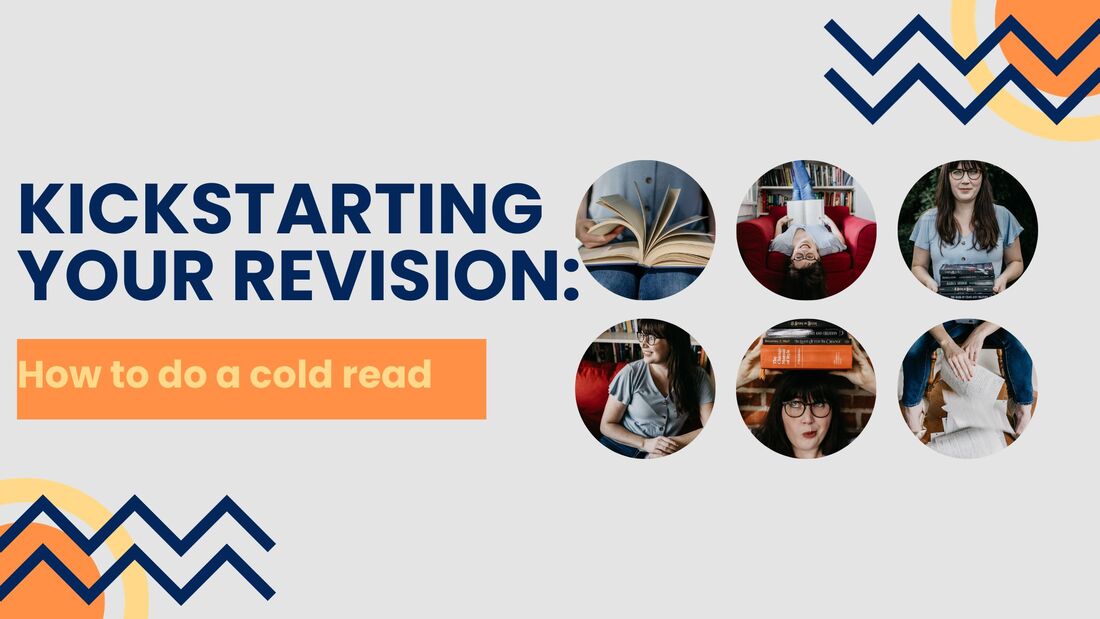
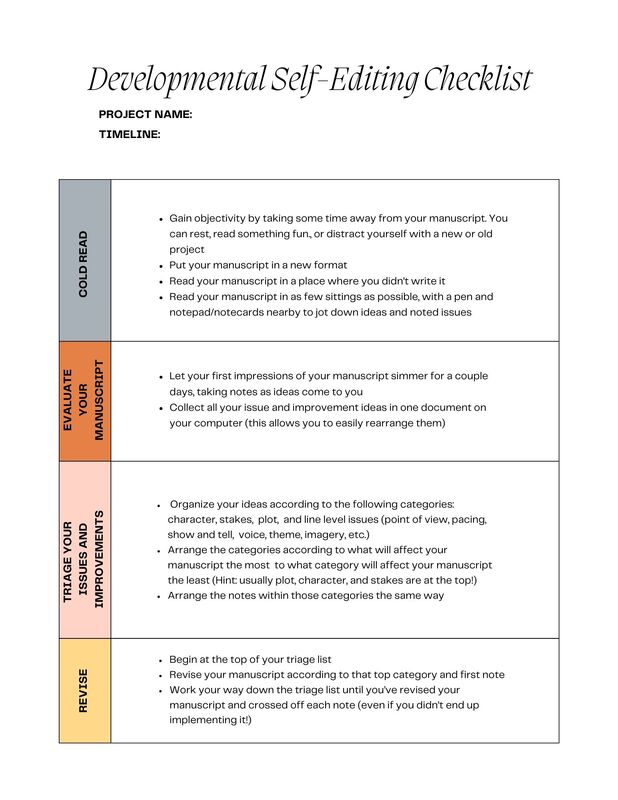
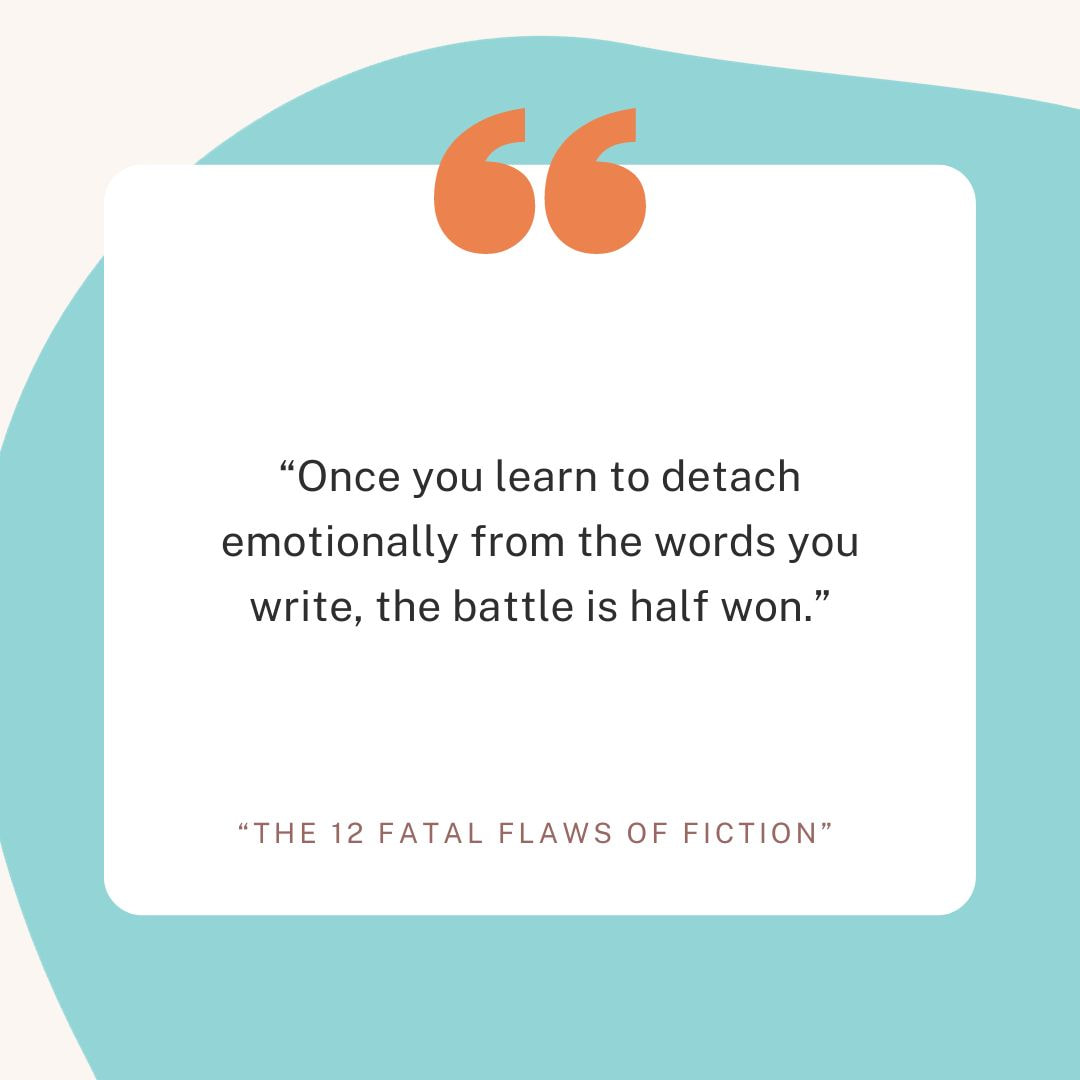
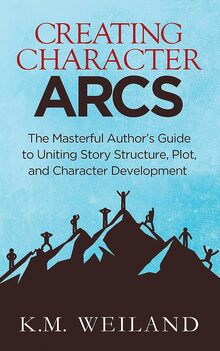
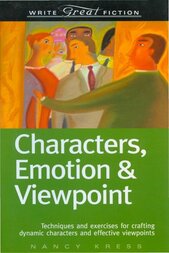
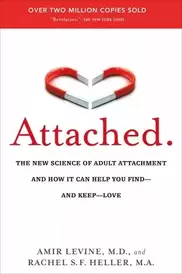
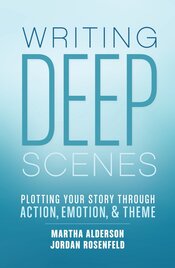
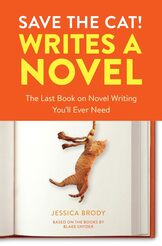
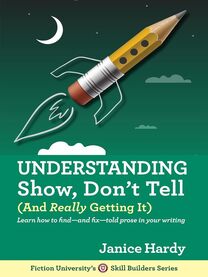
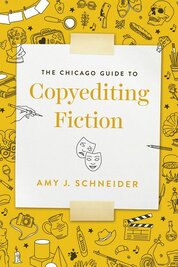
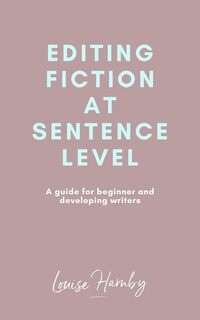
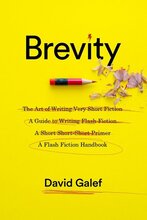
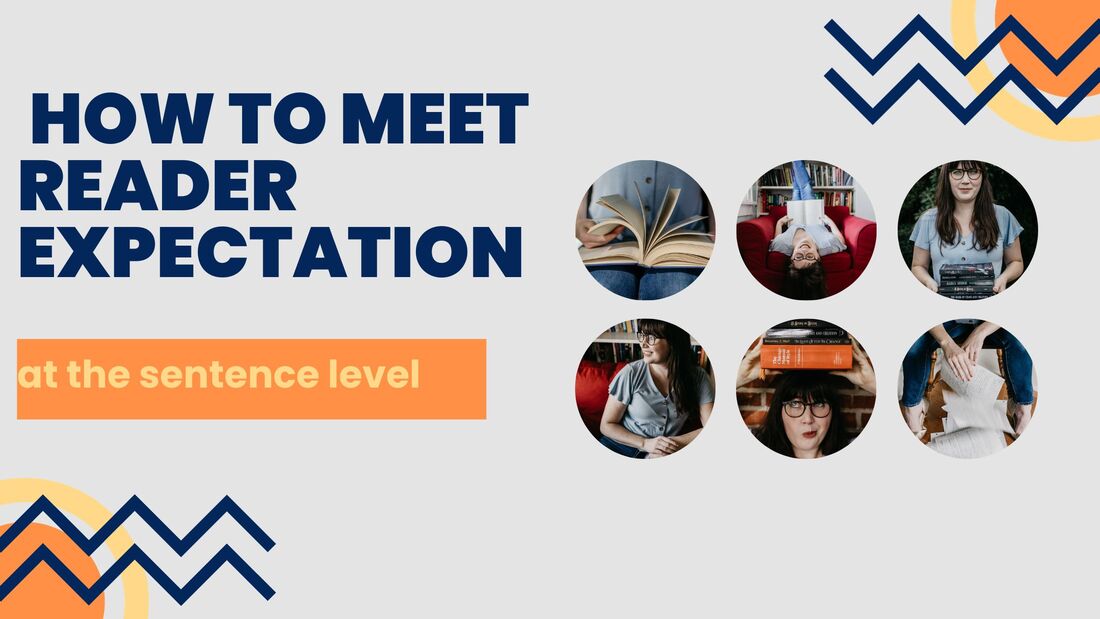
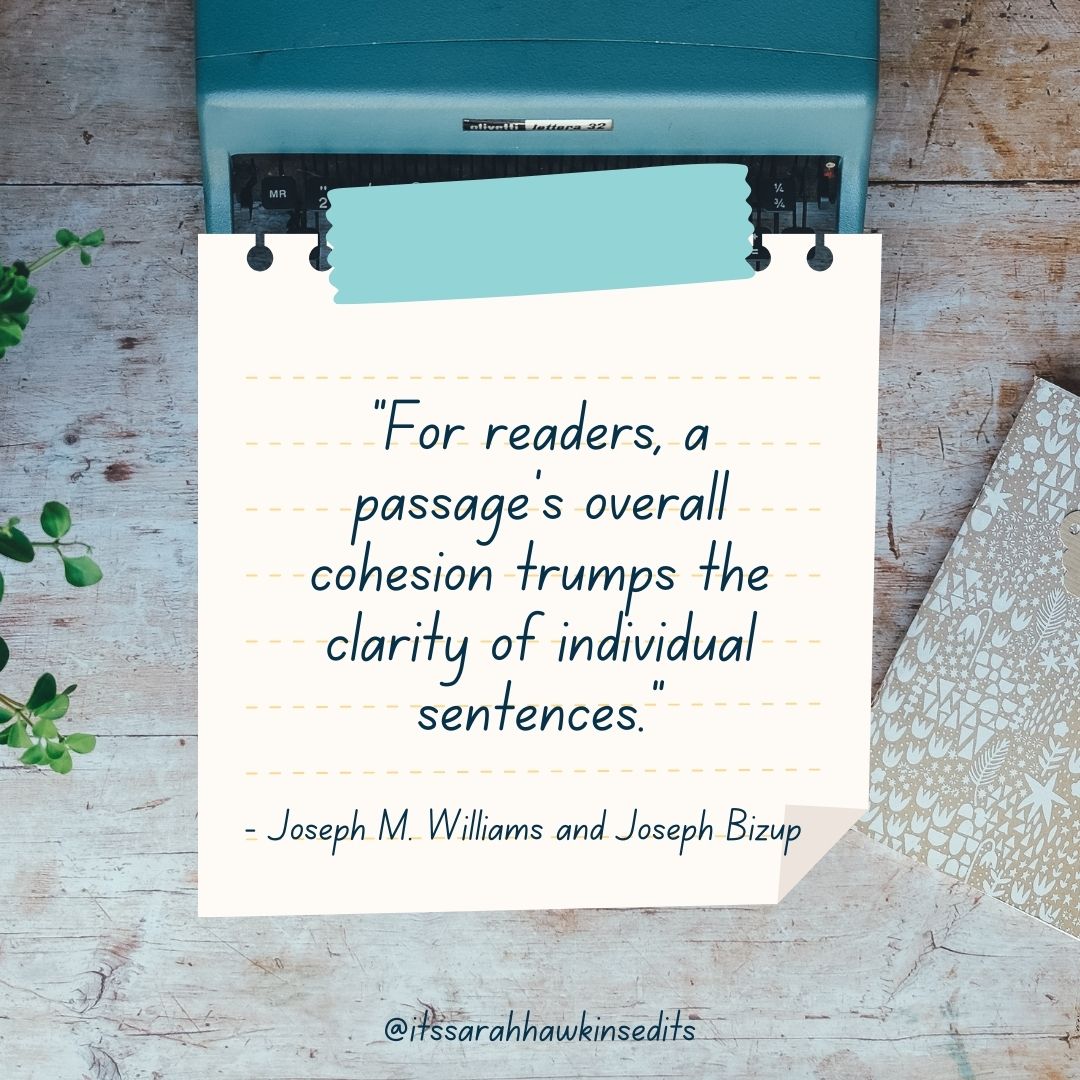
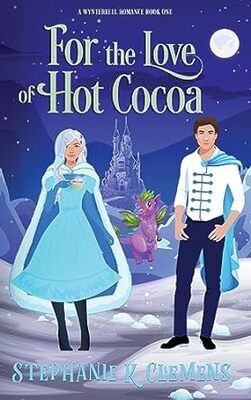
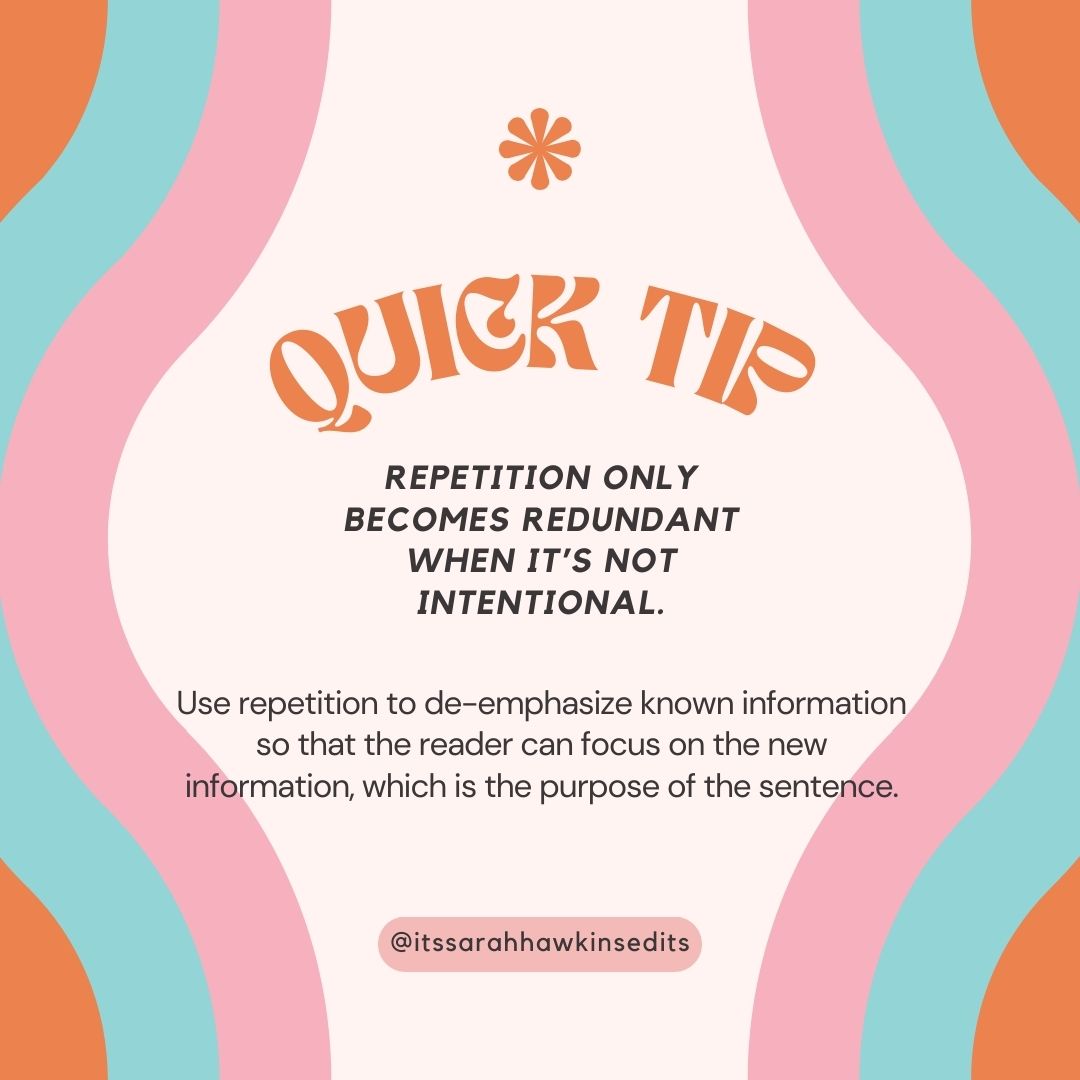
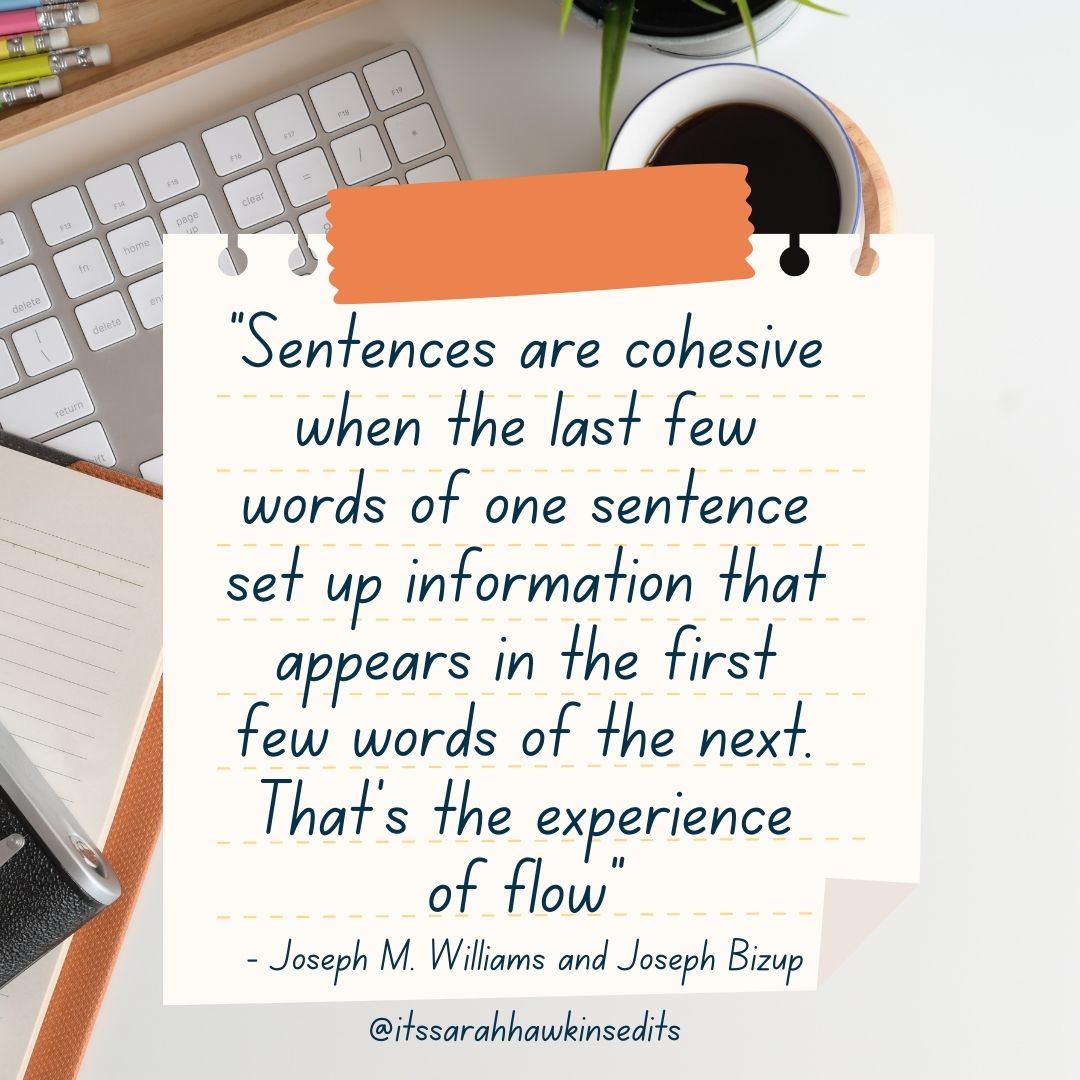
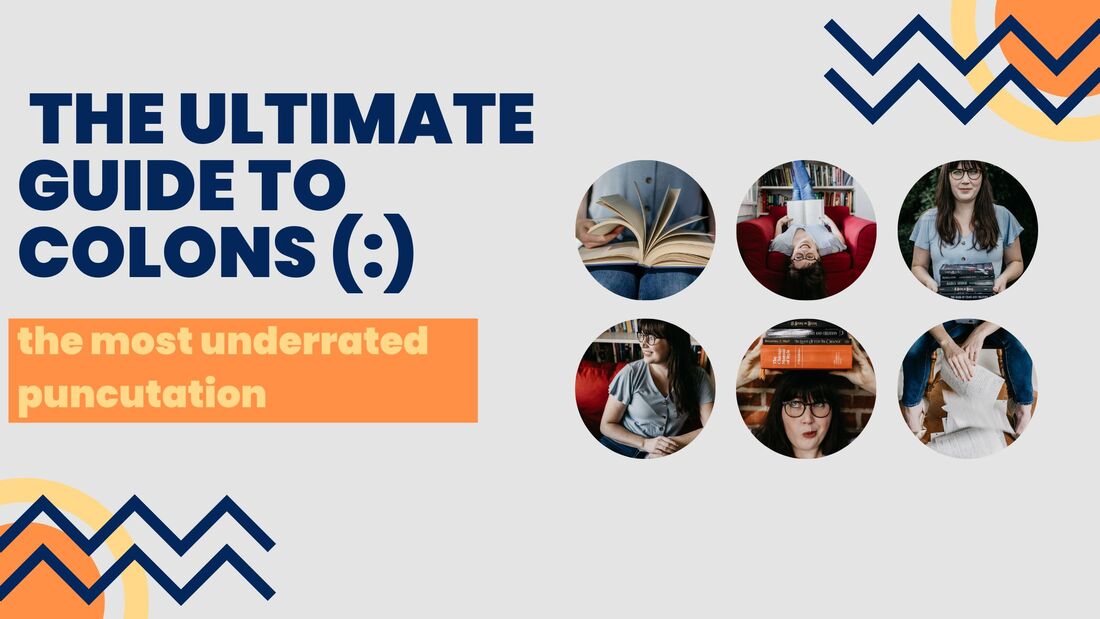
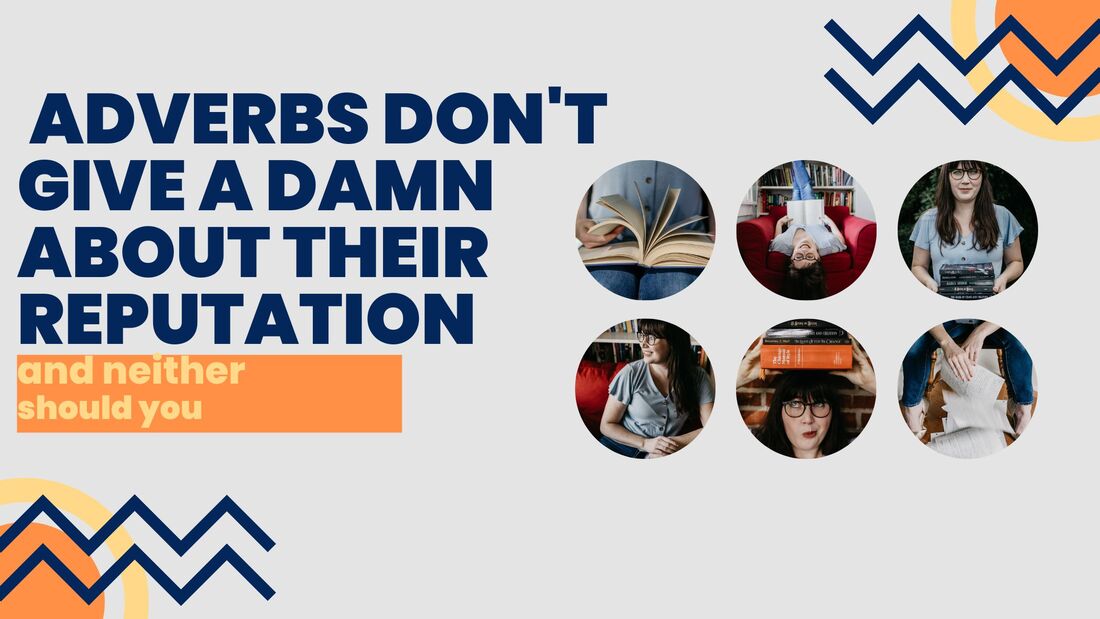
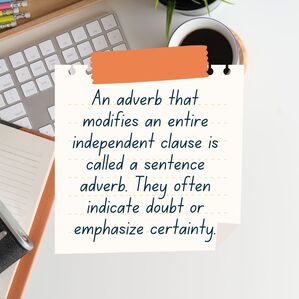
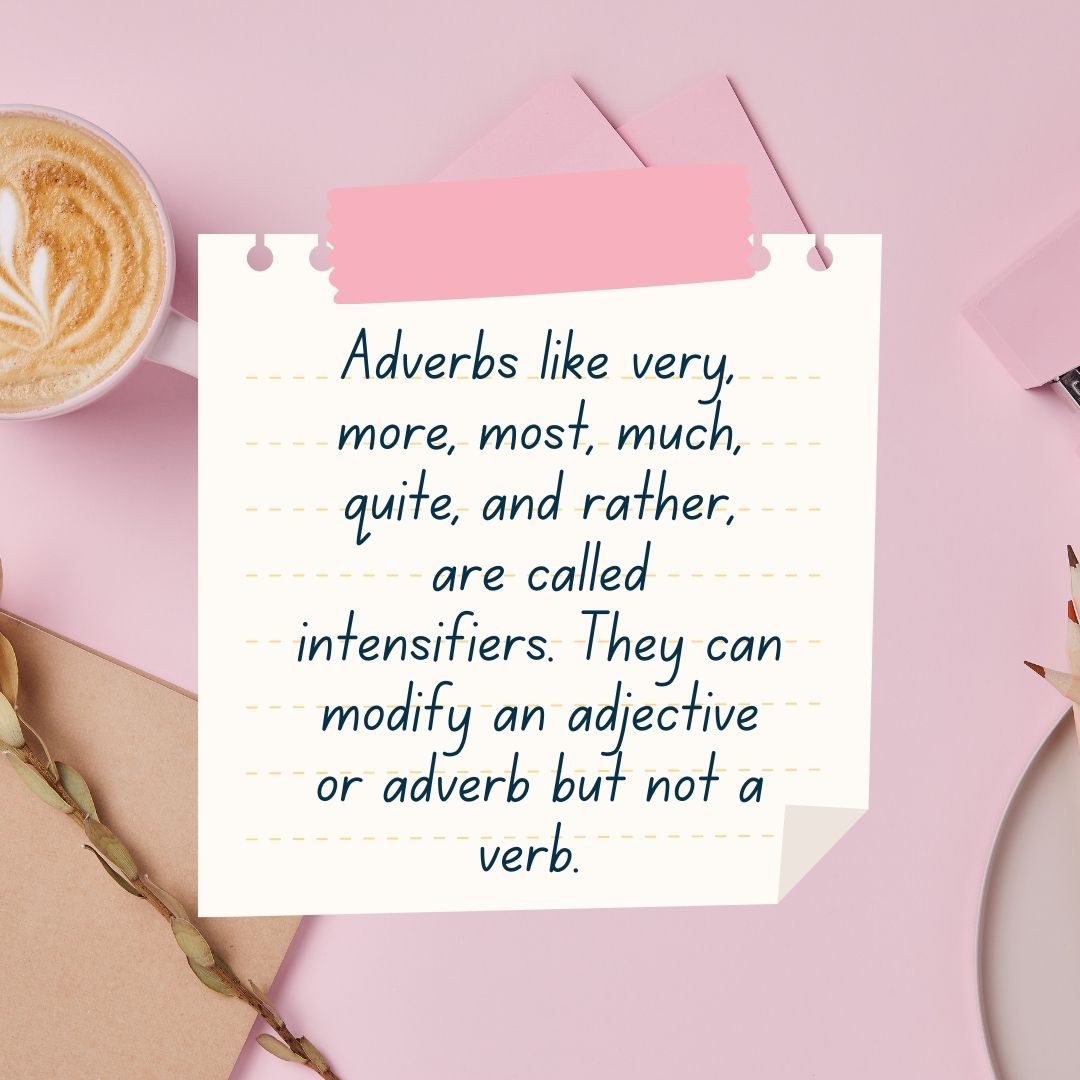
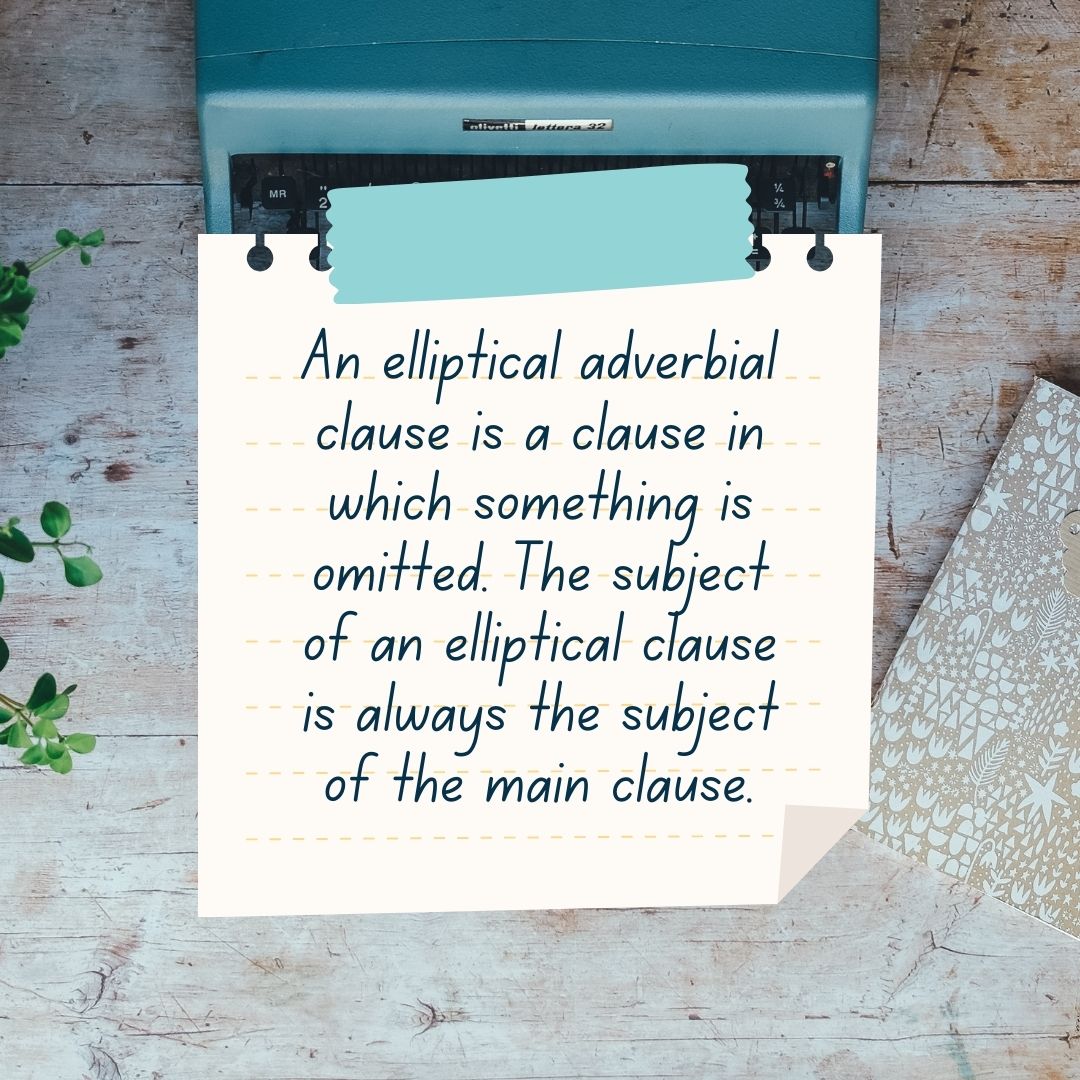
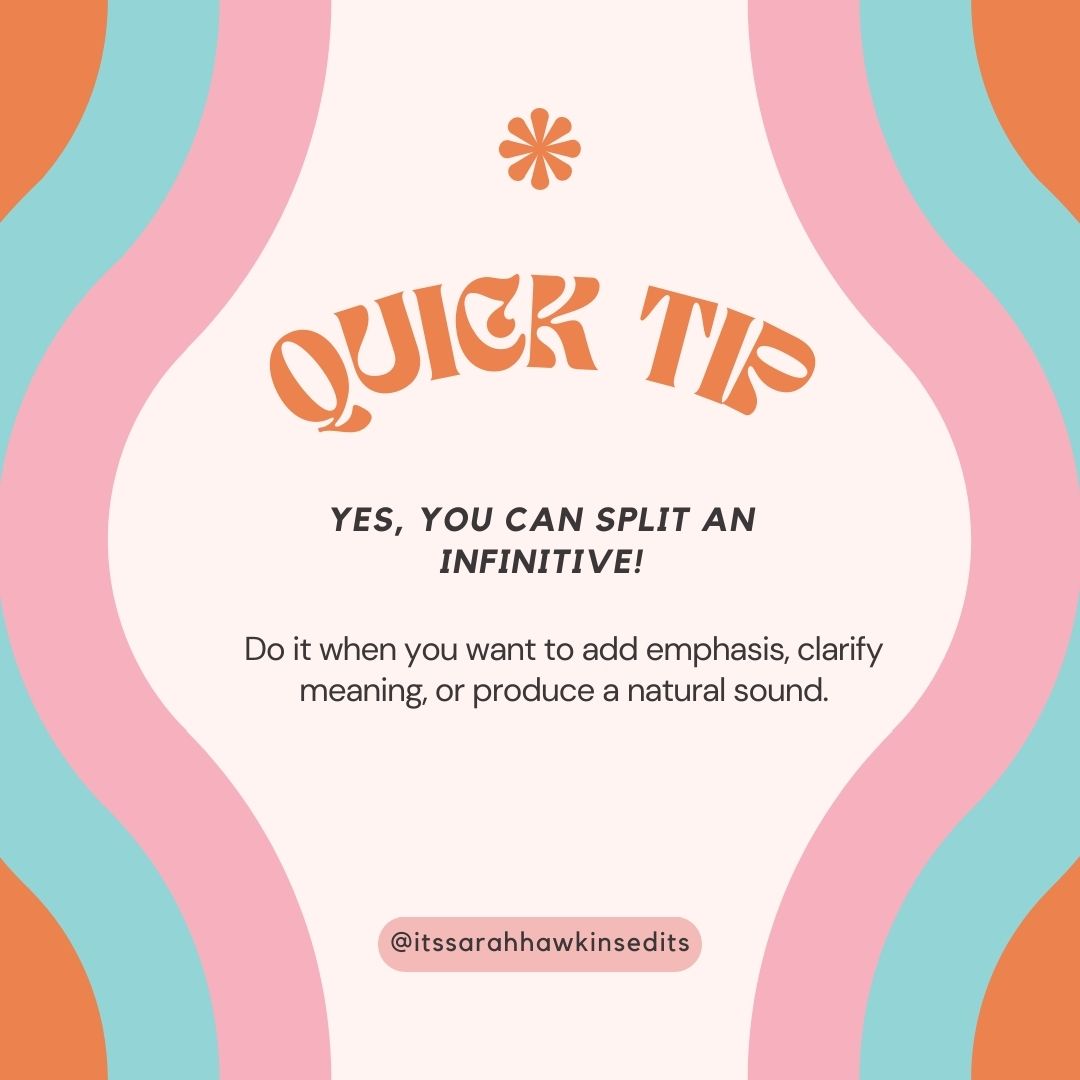
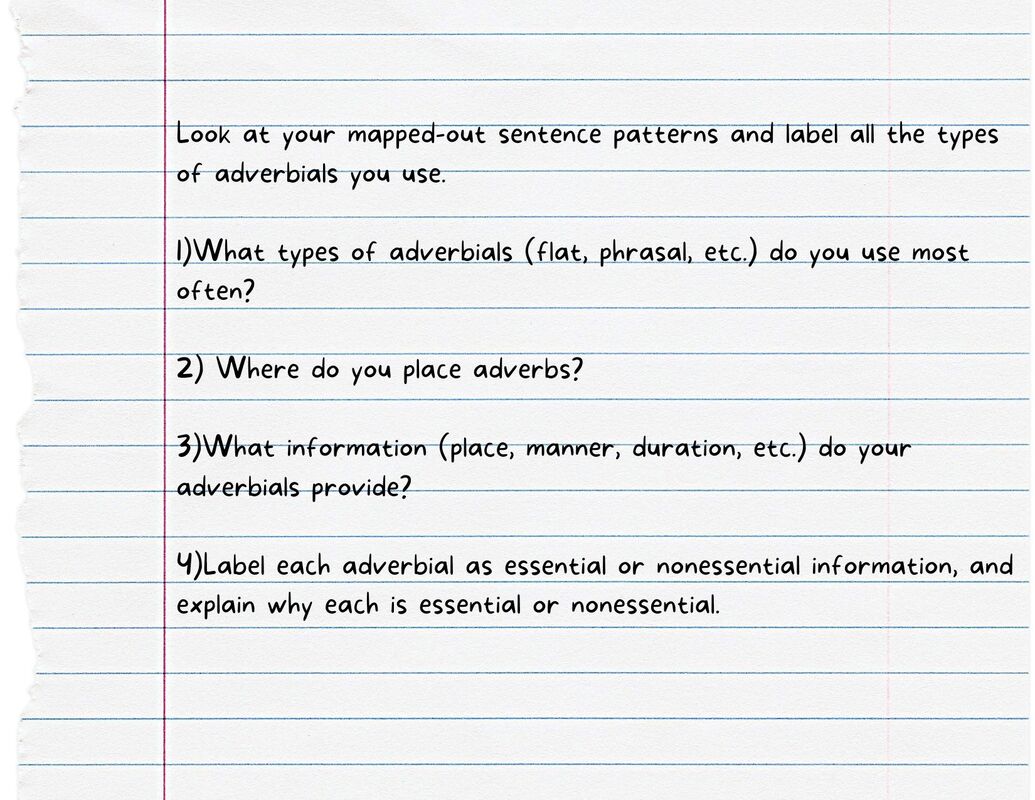
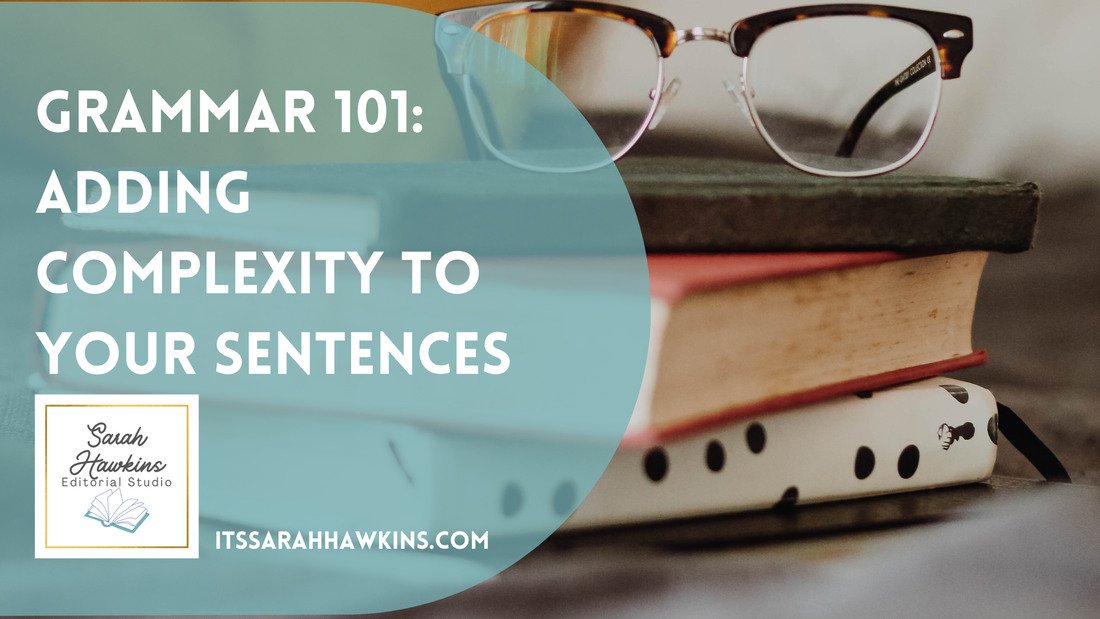
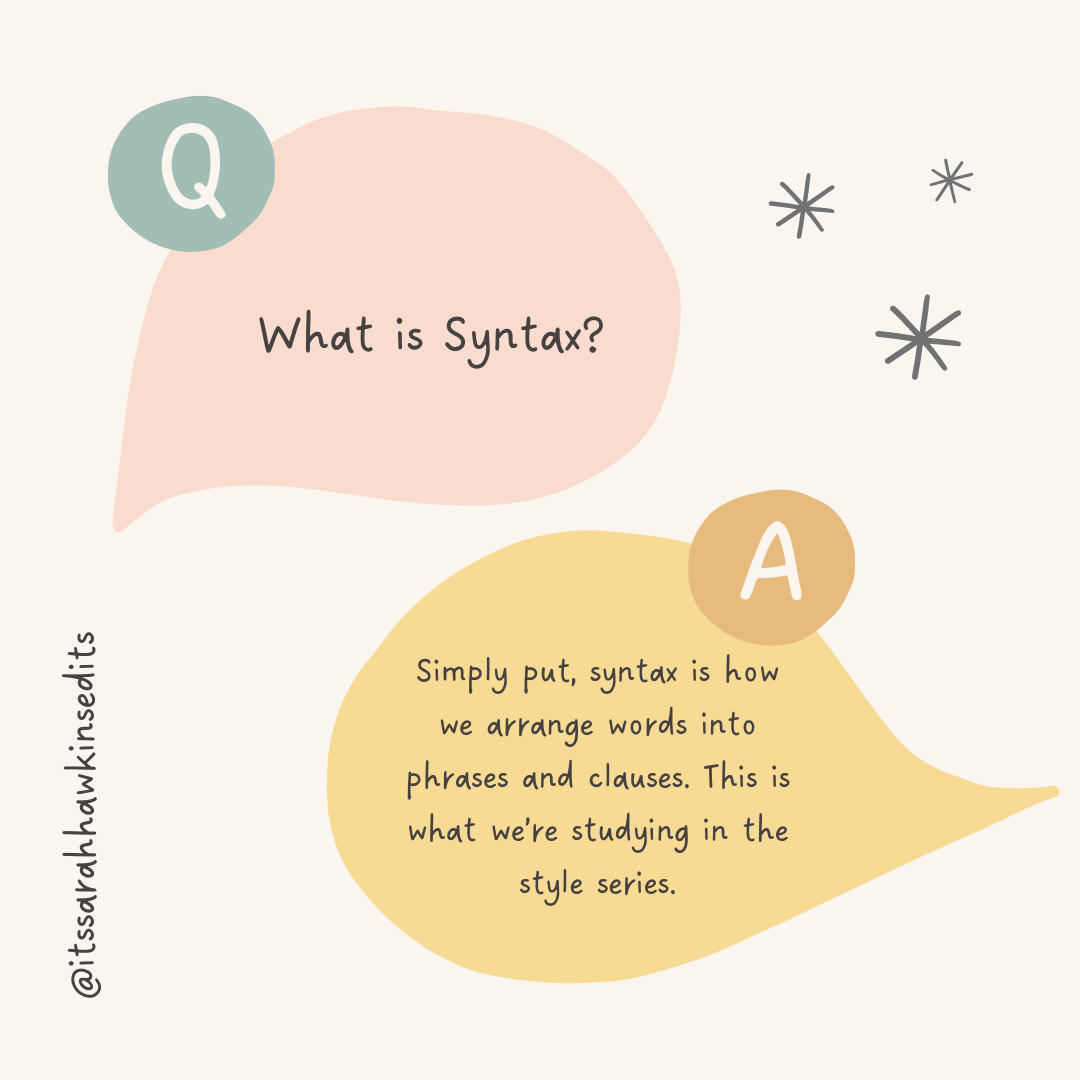
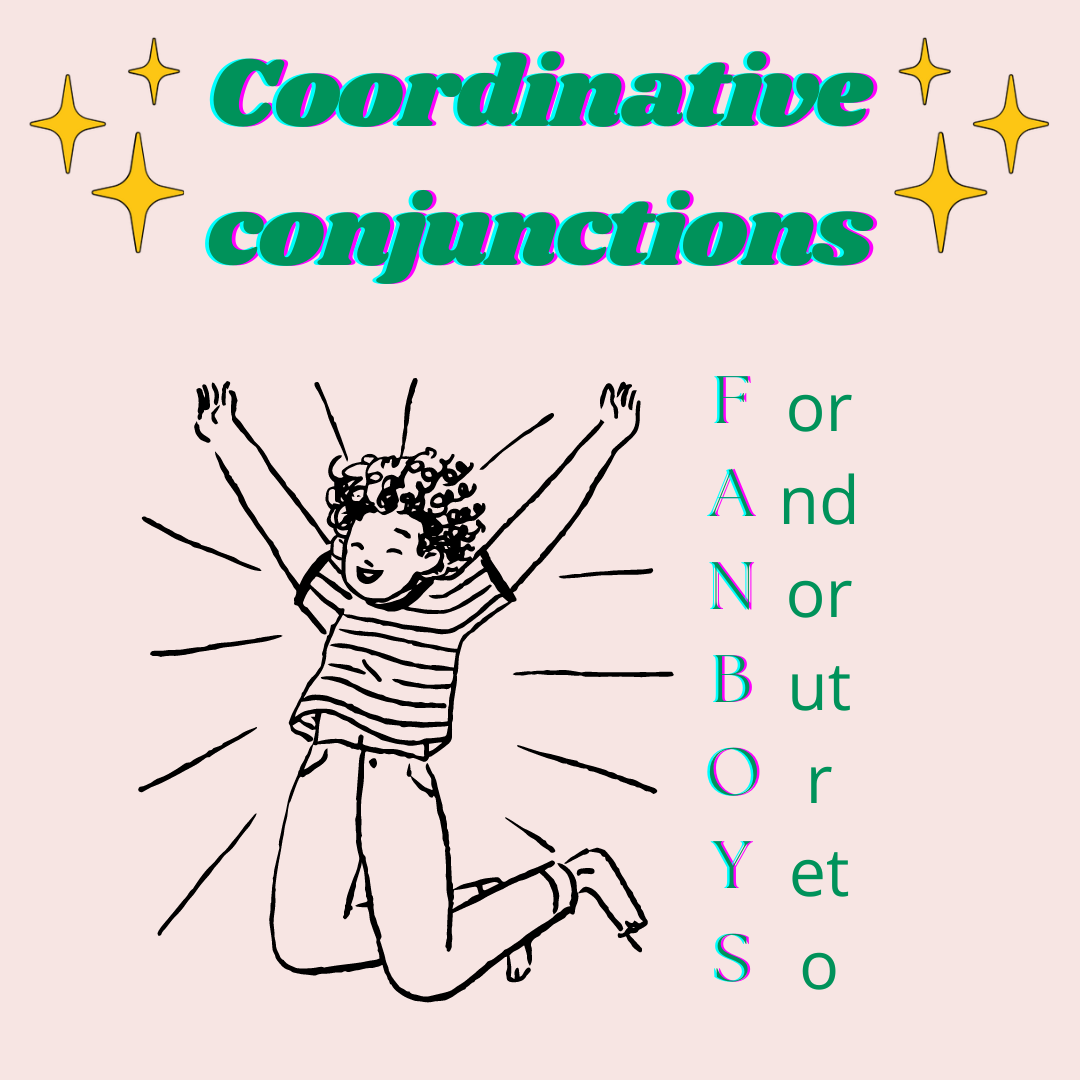
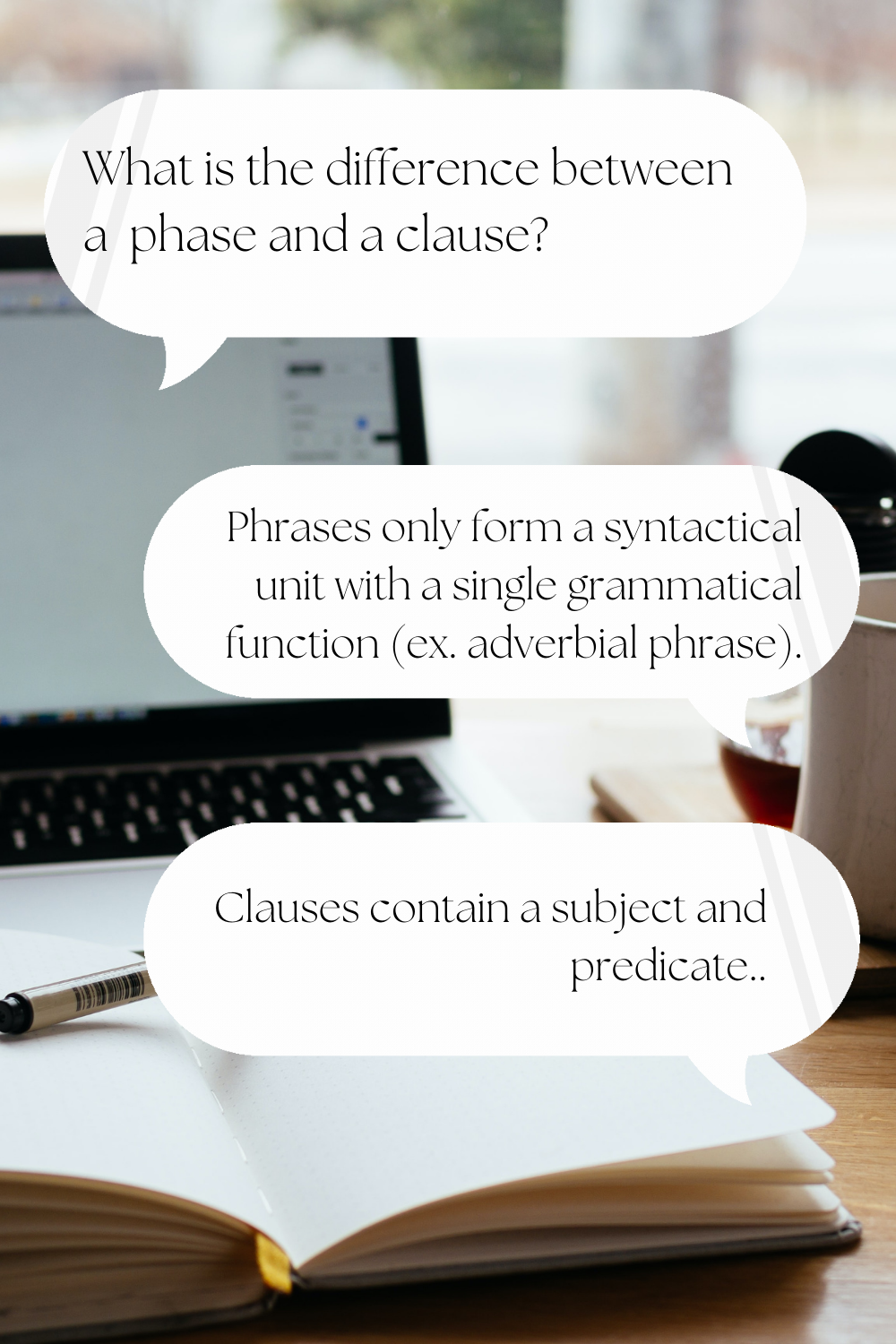
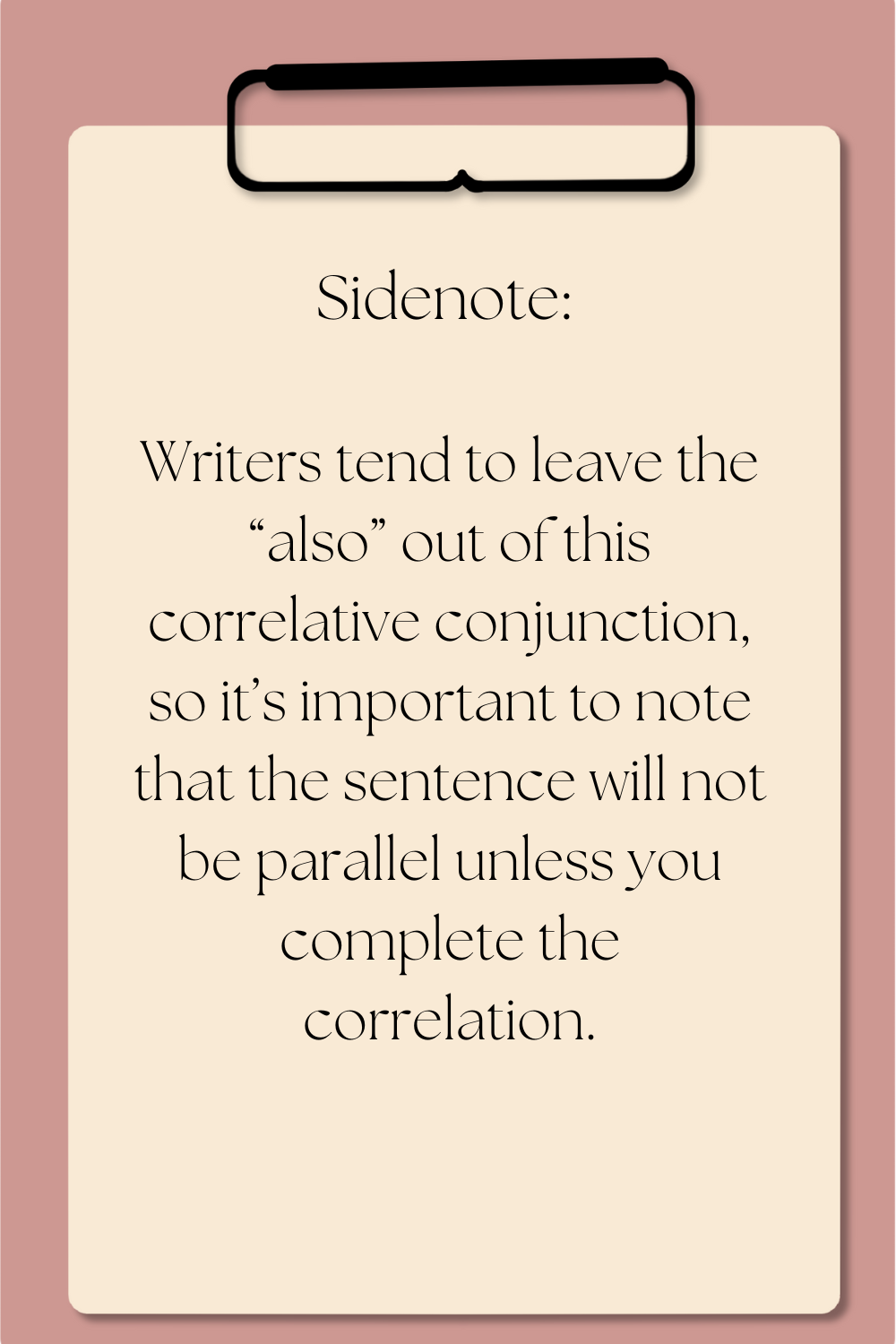
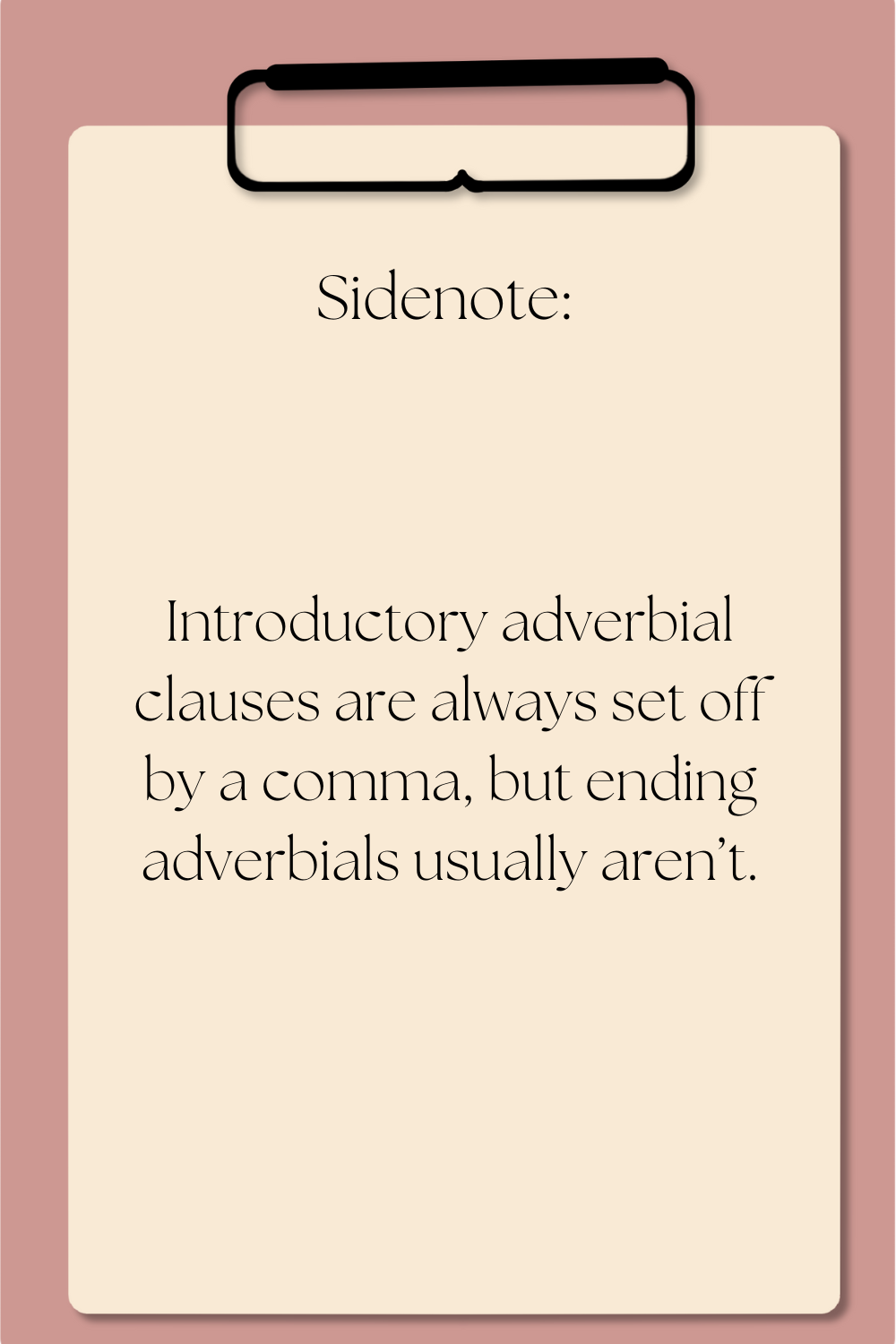
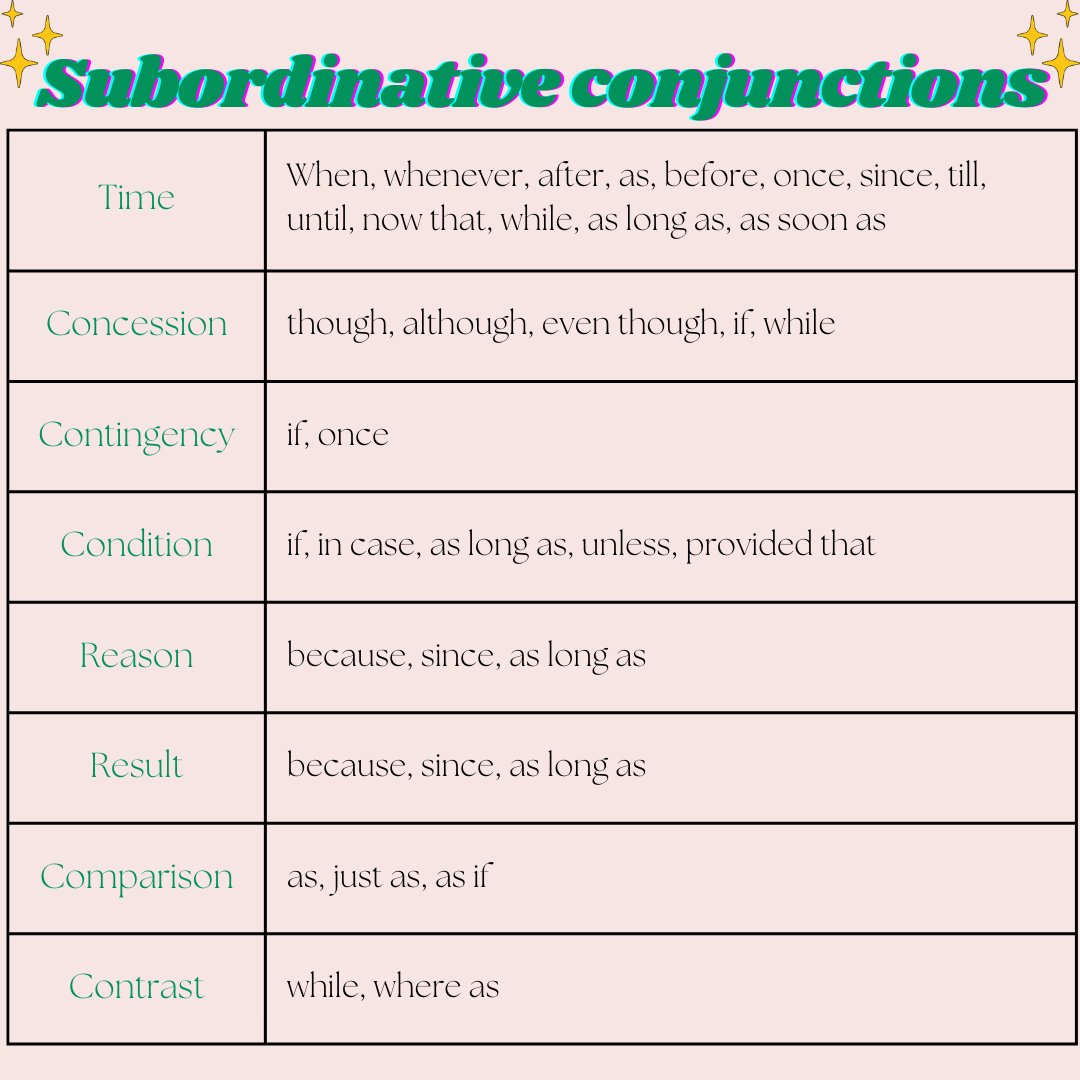
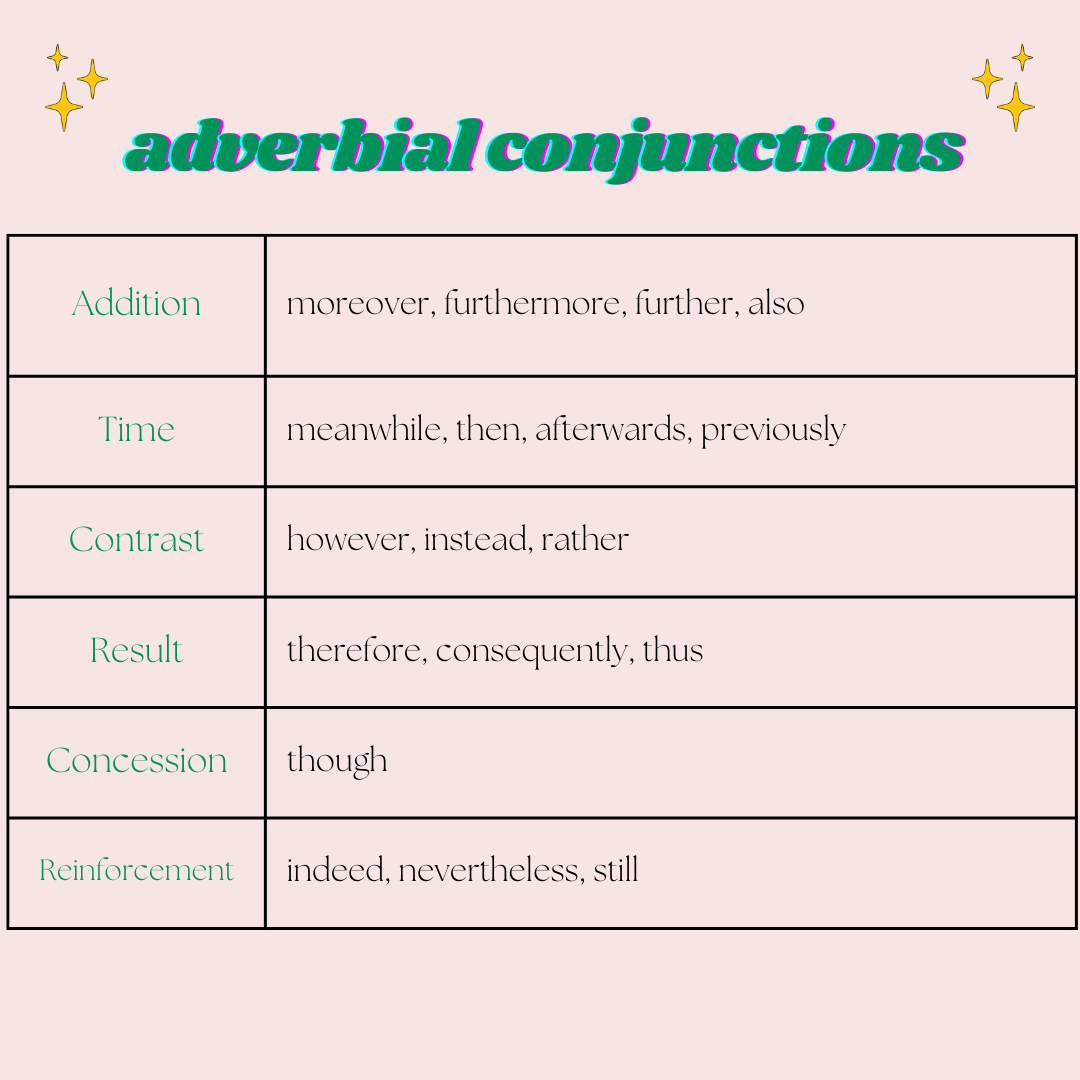

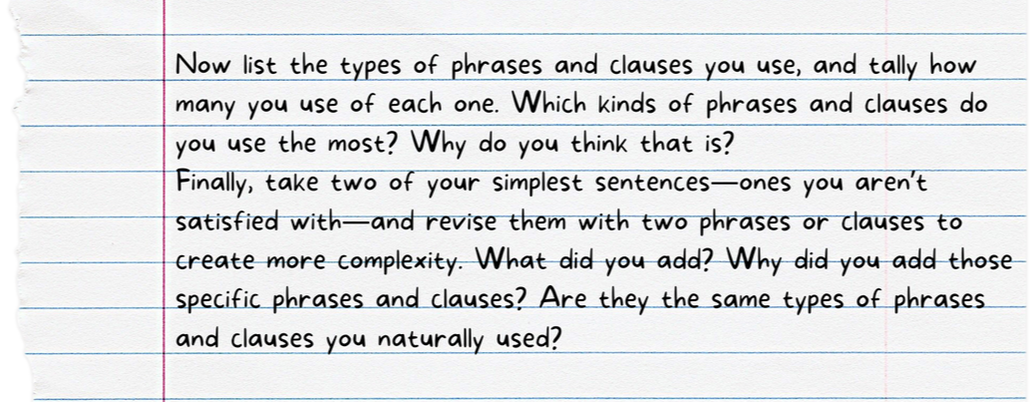
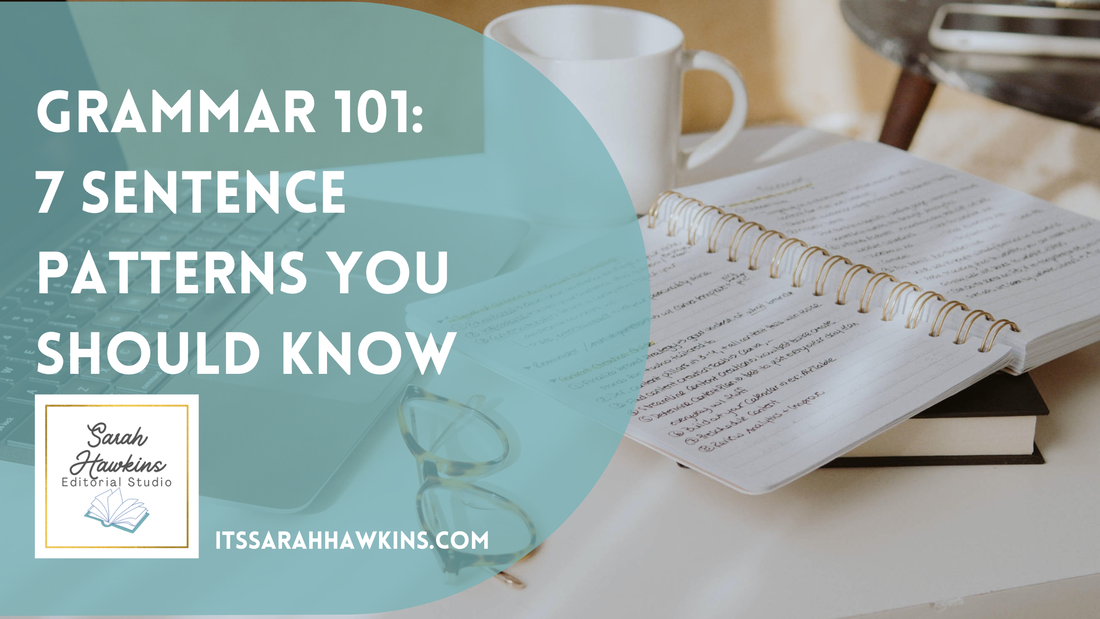





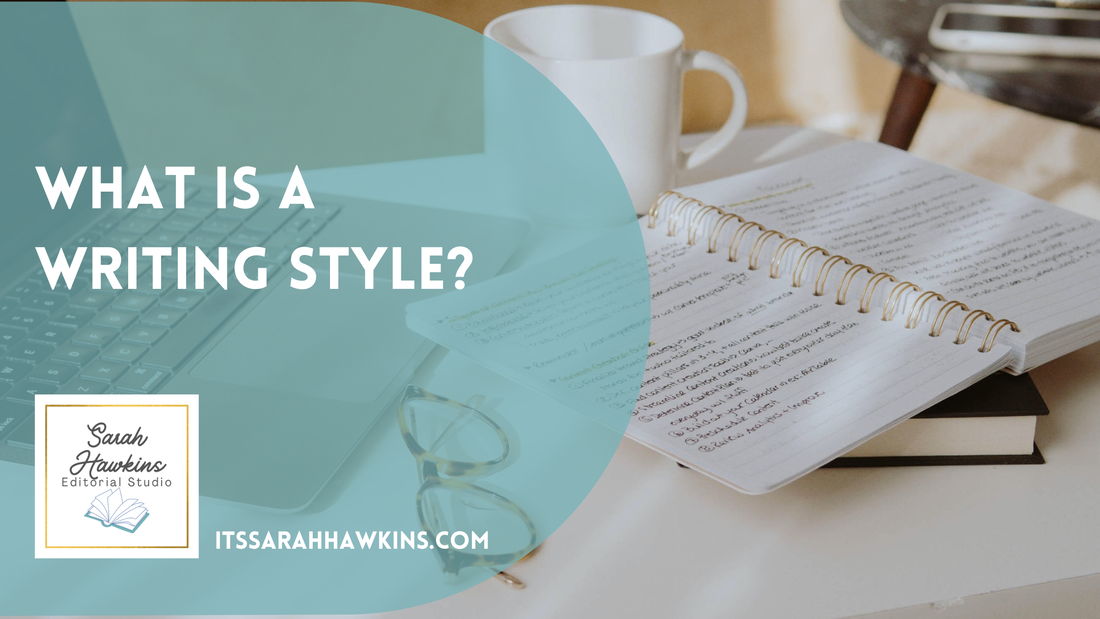
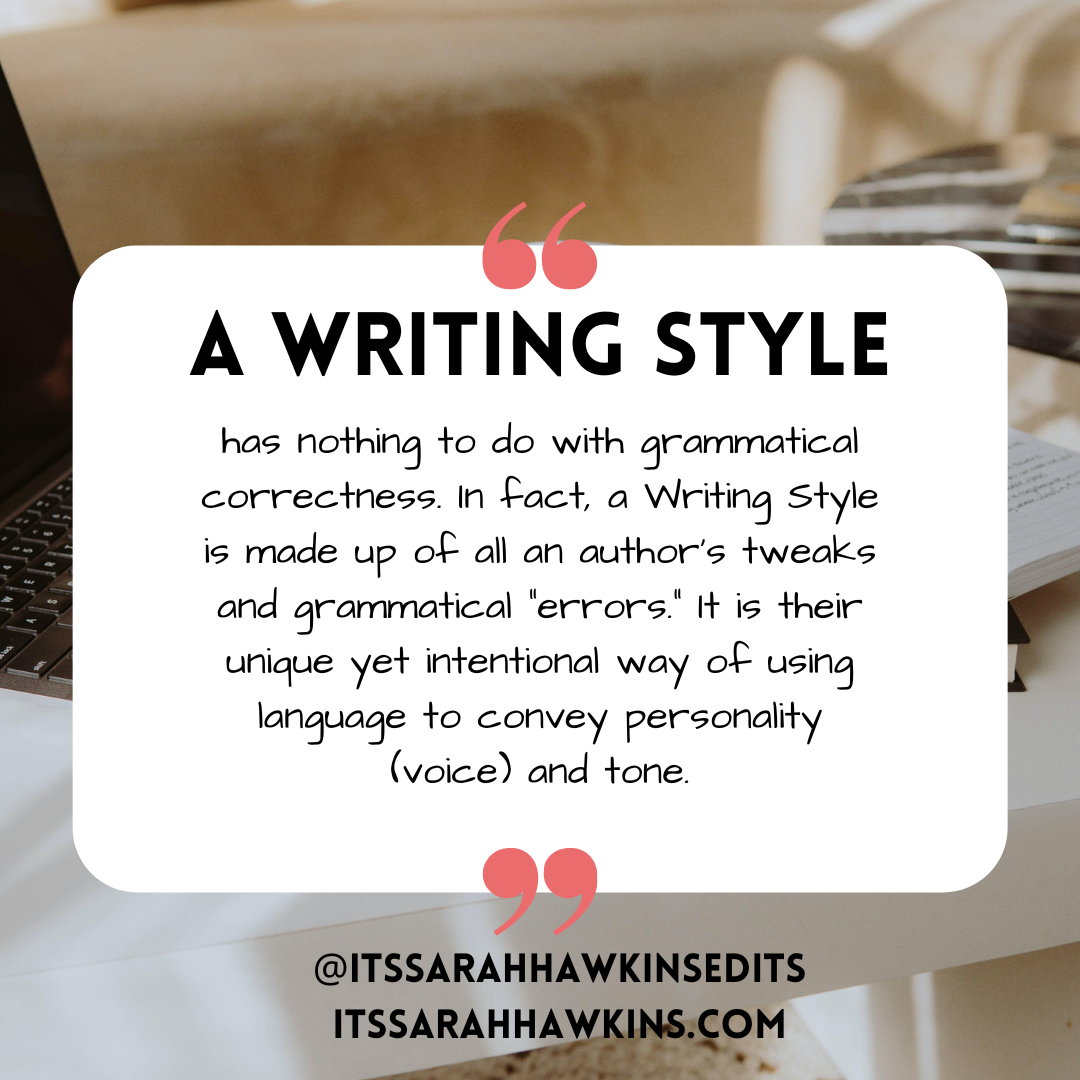
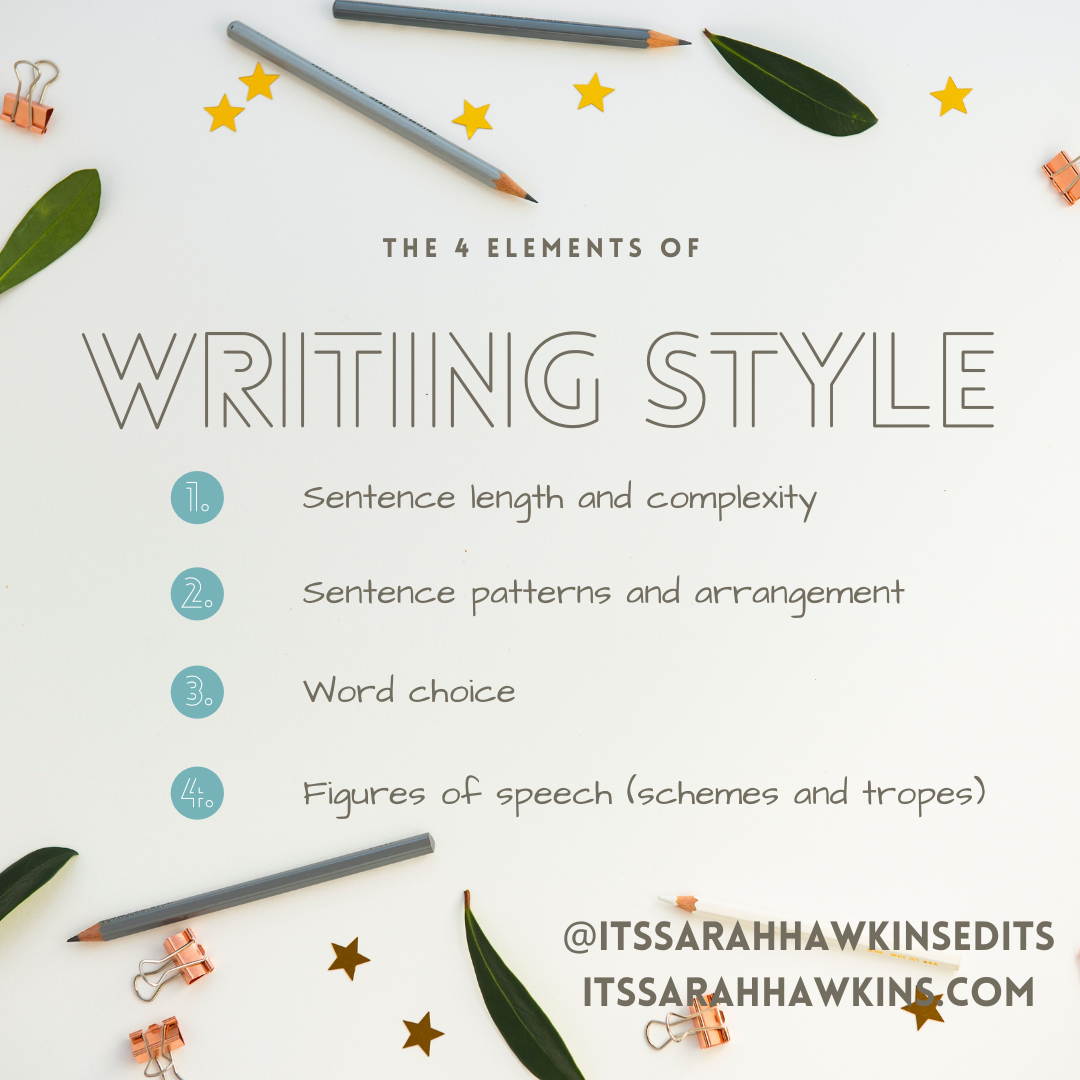
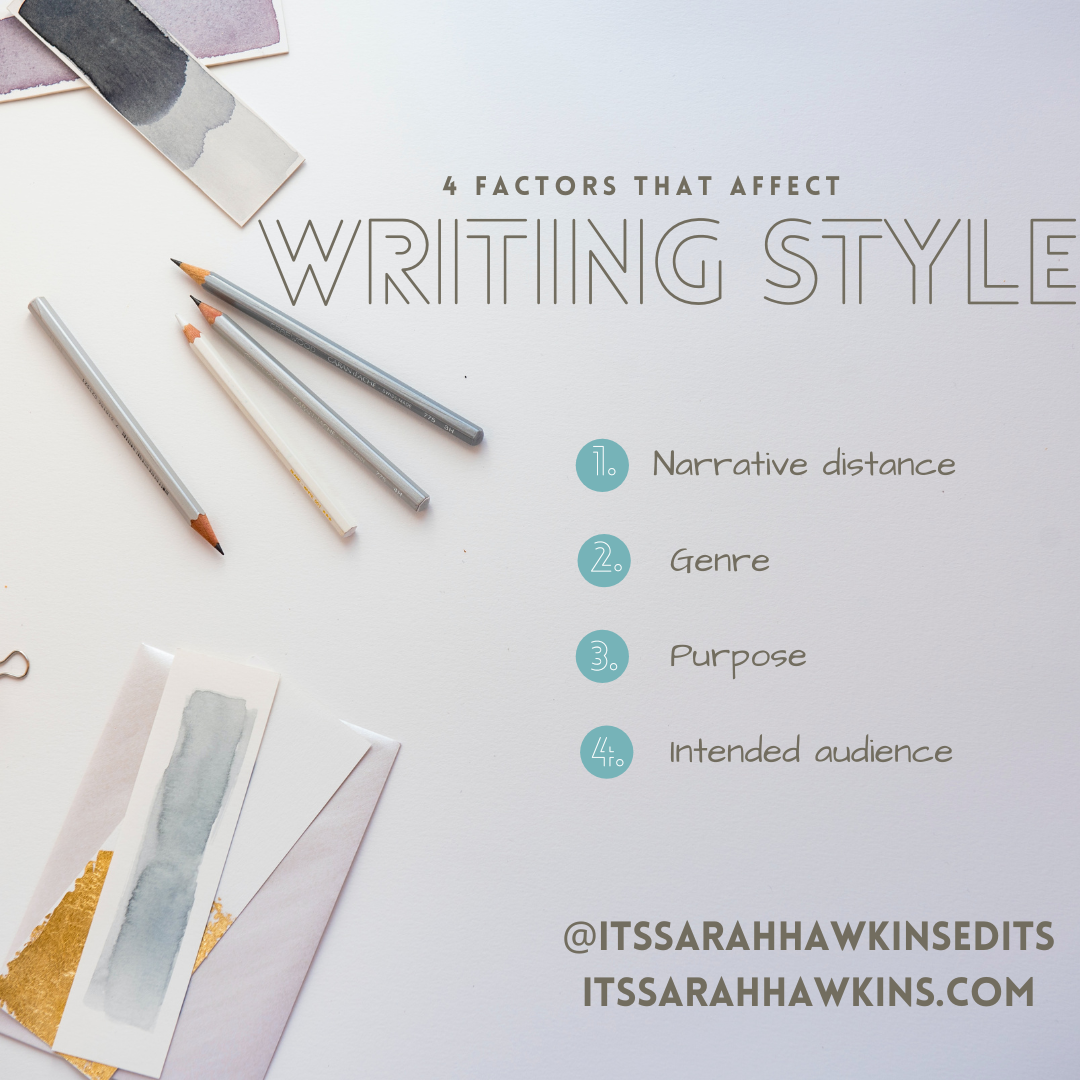
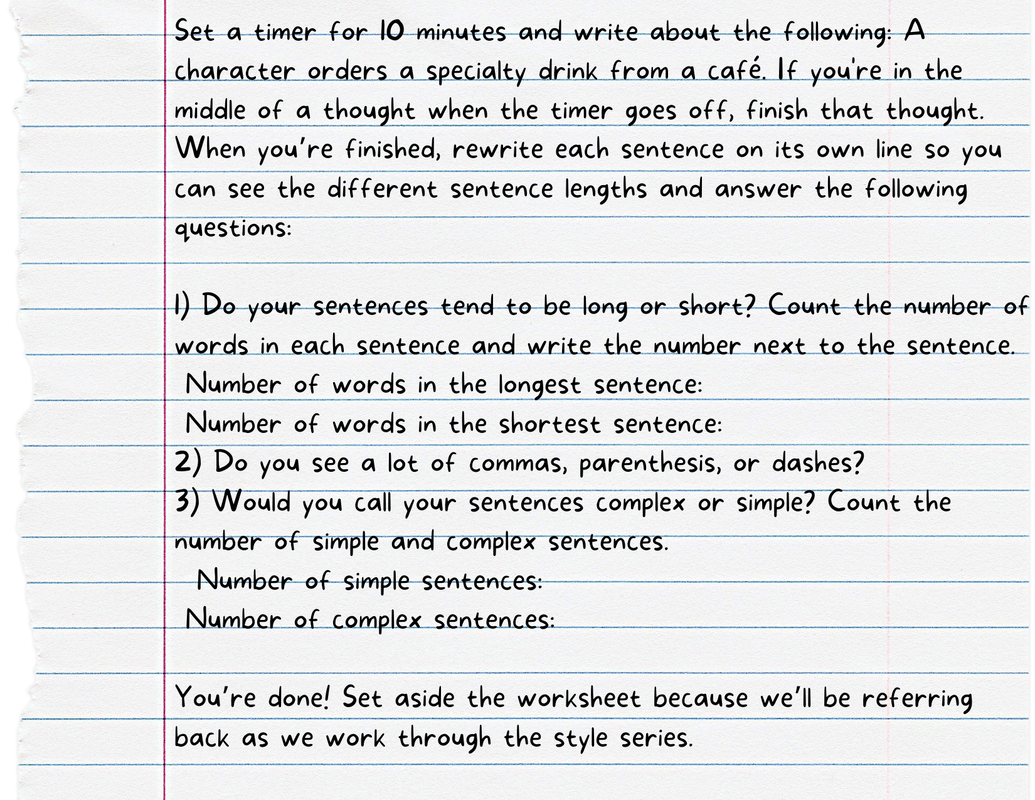
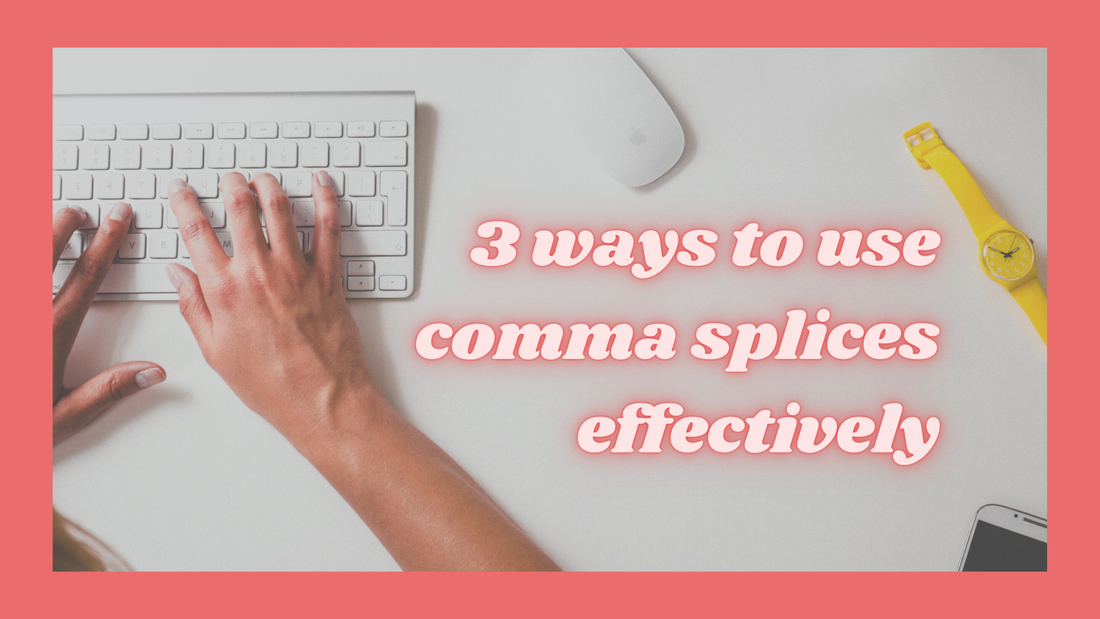

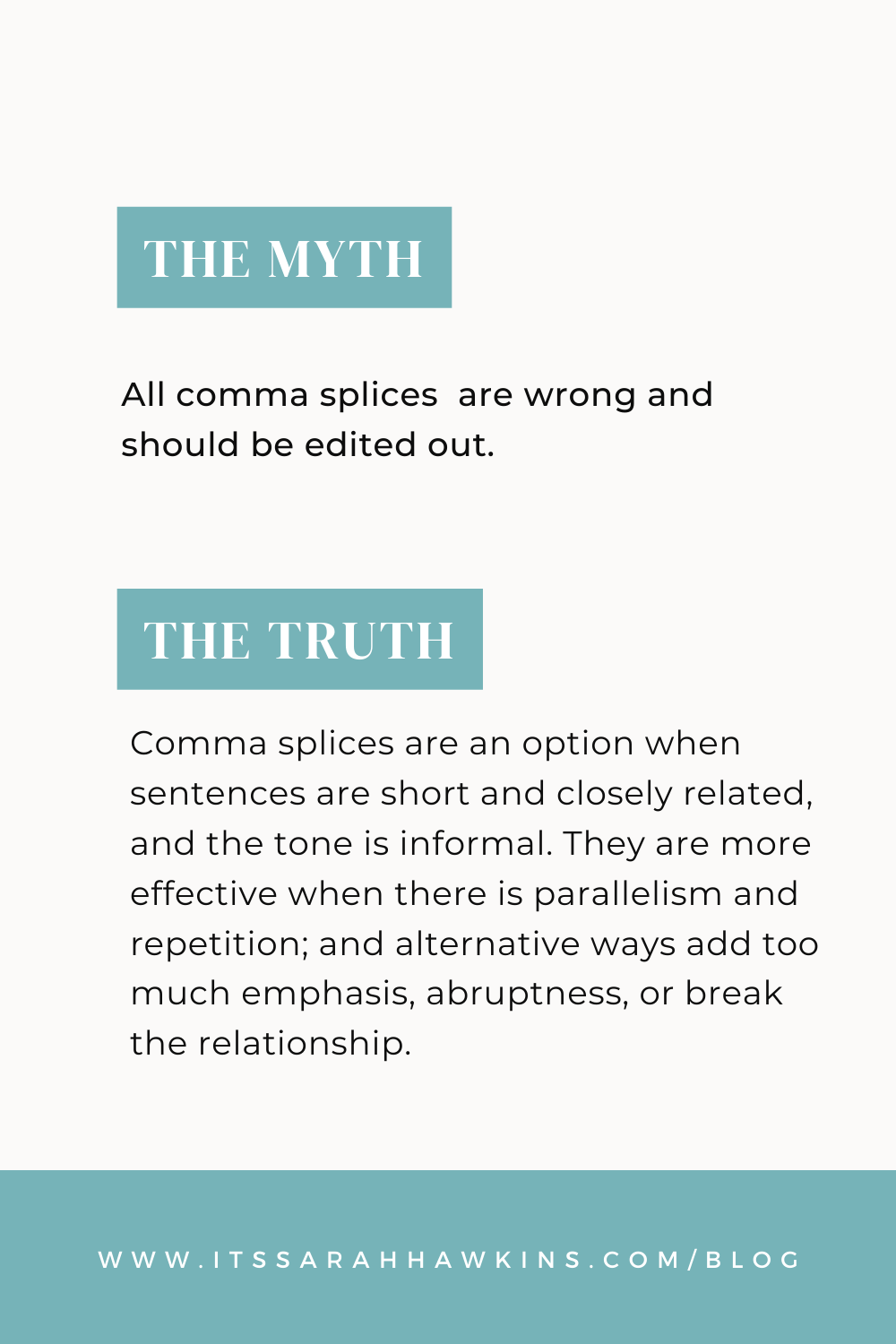
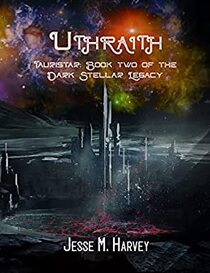

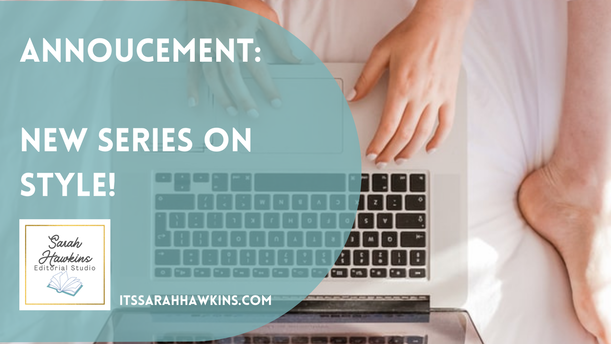
 RSS Feed
RSS Feed
